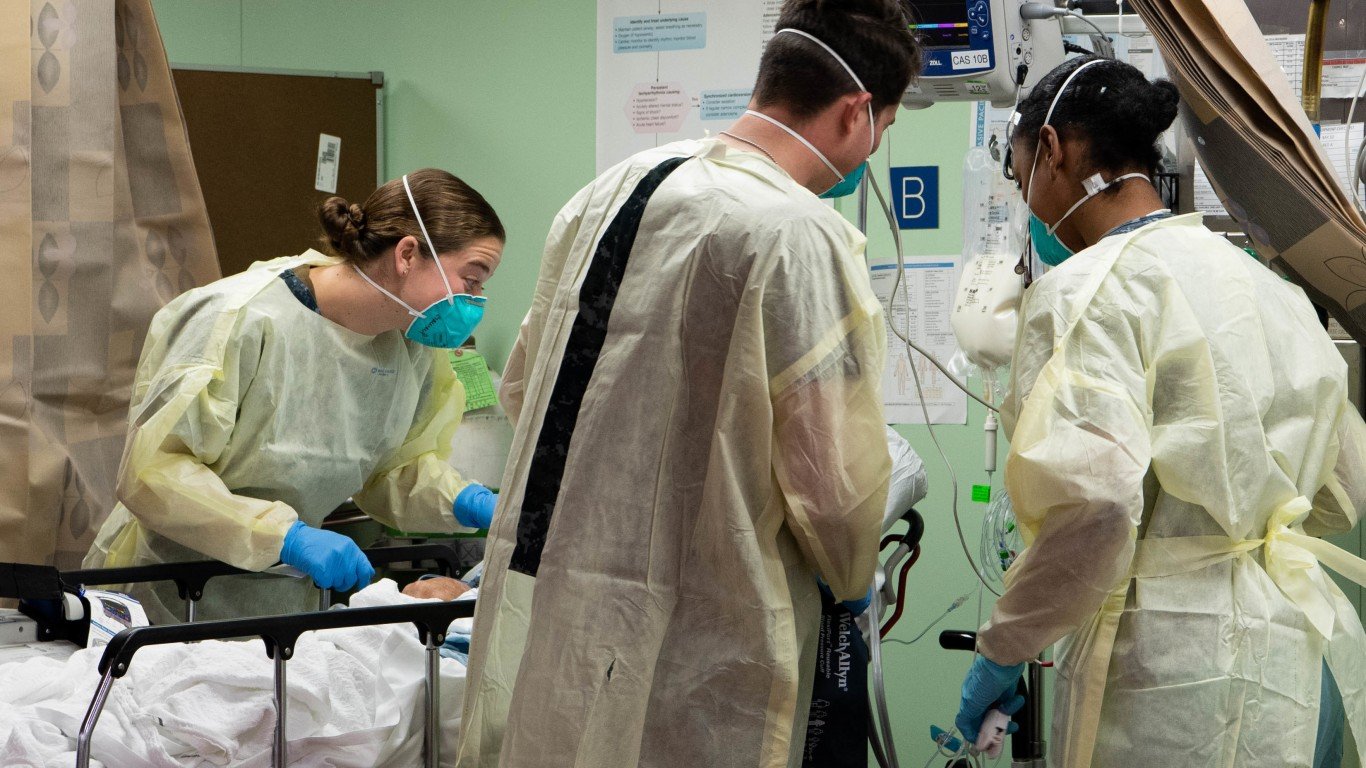

The U.S. reported over 64,000 new cases of coronavirus on Feb. 17, bringing the total count to more than 27,400,000 confirmed cases of COVID-19. There have been more than 470,000 COVID-19-related deaths — the highest death toll of any country.
New cases continue to rise, albeit at a slowing rate. In the past week, there were an average of 27.8 daily new coronavirus cases per 100,000 Americans — a decrease from the week prior, when there were an average of 39 daily new coronavirus cases per 100,000 people.
While new data shows that the risk of contracting COVID-19 is high in almost every part of the country, cities continue to be the sites of major outbreaks and superspreader events. Experts agree that the virus is more likely to spread in group settings where large numbers of people routinely have close contact with one another, such as colleges, nursing homes, bars, and restaurants. Metropolitan areas with a high degree of connectivity between different neighborhoods and a large population may be particularly at-risk.
The metro areas with the highest incidence of COVID-19 cases are distributed relatively unevenly across the United States. Of the 50 metro areas with the highest case counts per capita, 26 are in the South, 16 are in the Midwest, eight are in the West, and zero are in the Northeast.
The five metro areas with the highest number of coronavirus cases per capita are: Yuma, AZ; Pine Bluff, AR; Lubbock, TX; Laredo, TX; and Bismarck, ND. The incidence of COVID-19 in these metro areas range from 17,398.9 cases per 100,000 to 15,511.7 cases per 100,000. For comparison, there are currently 8,511.6 cases per 100,000 Americans nationwide.
The 50 cities with the highest incidence of COVID-19 have over 12,100 more coronavirus cases per capita than the U.S. as a whole, but cases are growing at a slowing rate. There were an average of 35.5 daily new coronavirus cases per 100,000 people in the week ending Feb. 17, a decrease from the week prior, when there were an average of 46.3 daily new coronavirus cases per 100,000 people. In five of the 50 cities with the highest COVID-19 incidence, new cases are rising at an increasing rate.
To determine the cities with the most COVID-19 cases, 24/7 Wall St. compiled and reviewed data from state and local health departments. We ranked metro areas based on the number of confirmed COVID-19 cases per 100,000 residents as of Feb. 17. To estimate the incidence of COVID-19 at the metropolitan level, we aggregated data from the county level using boundary definitions from the U.S. Census Bureau. Population data used to adjust case and death totals came from the U.S. Census Bureau’s 2018 American Community Survey and are five-year estimates. Unemployment data is from the Bureau of Labor Statistics and is seasonally adjusted.
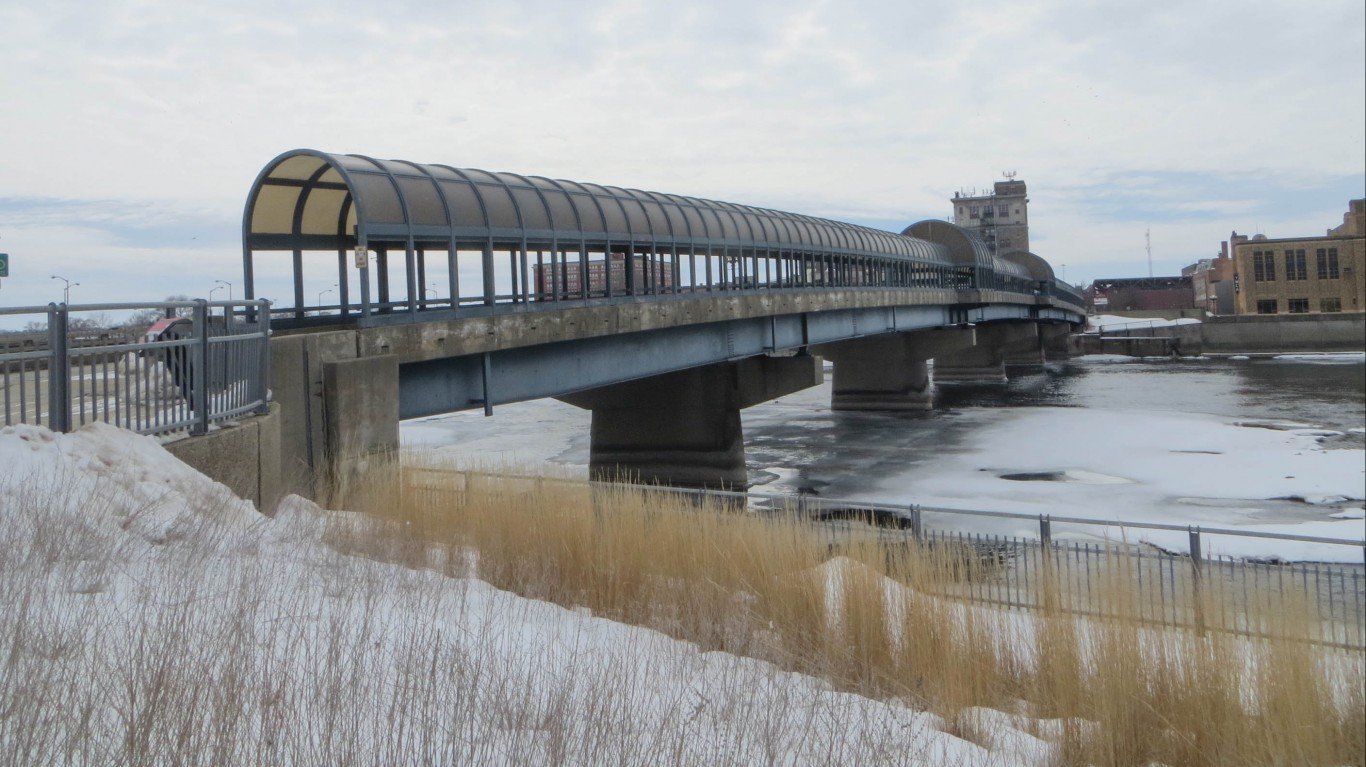
50. Waterloo-Cedar Falls, IA
> Confirmed COVID-19 cases as of Feb. 17: 18,634
> Confirmed COVID-19 cases as of Feb. 17 per 100,000 residents: 10,952.7
> Cumulative COVID-19 deaths as of Feb. 17: 362
> Cumulative COVID-19 deaths as of Feb. 17 per 100,000 residents: 212.8
> Population: 170,132
These are all the counties in Iowa where COVID-19 is slowing (and where it’s still getting worse).

49. Kankakee, IL
> Confirmed COVID-19 cases as of Feb. 17: 12,231
> Confirmed COVID-19 cases as of Feb. 17 per 100,000 residents: 11,012.9
> Cumulative COVID-19 deaths as of Feb. 17: 189
> Cumulative COVID-19 deaths as of Feb. 17 per 100,000 residents: 170.2
> Population: 111,061
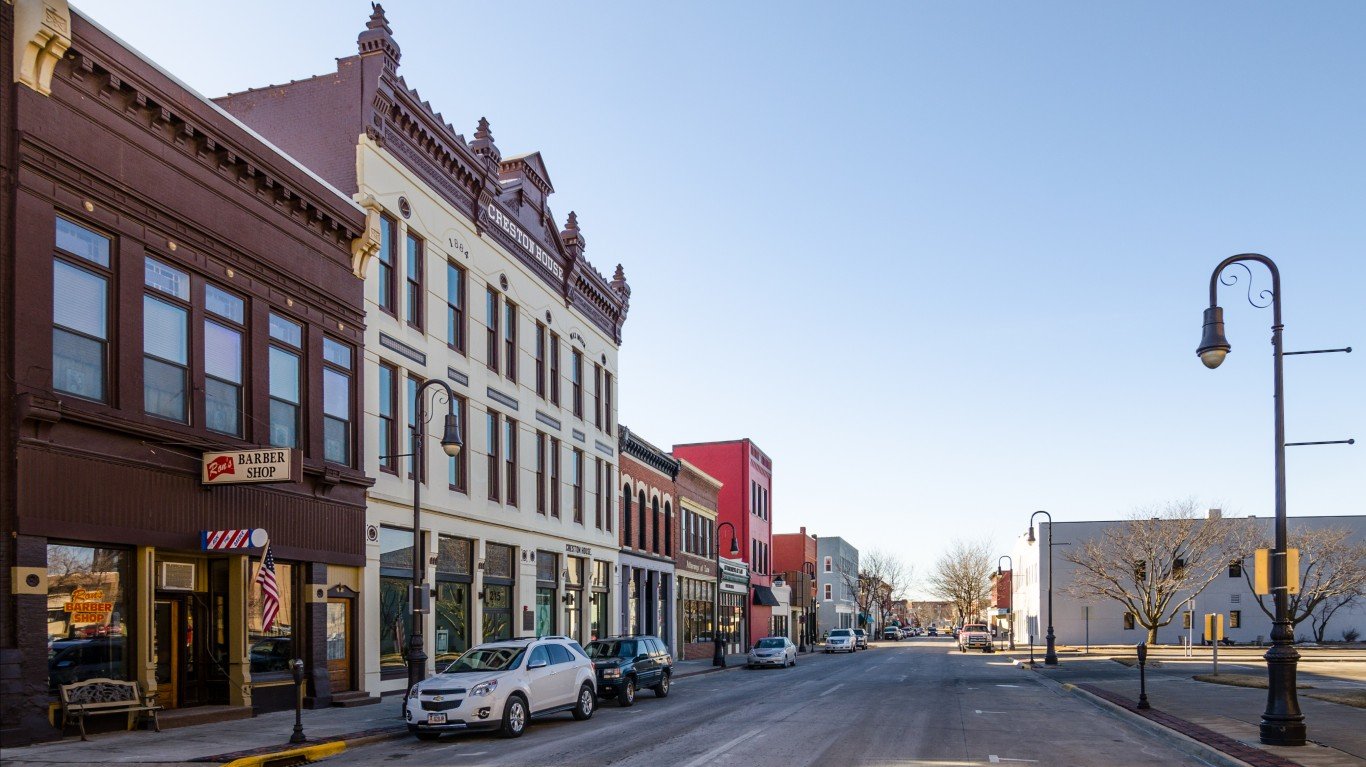
48. Omaha-Council Bluffs, NE-IA
> Confirmed COVID-19 cases as of Feb. 17: 101,659
> Confirmed COVID-19 cases as of Feb. 17 per 100,000 residents: 11,015.3
> Cumulative COVID-19 deaths as of Feb. 17: 986
> Cumulative COVID-19 deaths as of Feb. 17 per 100,000 residents: 106.8
> Population: 922,891
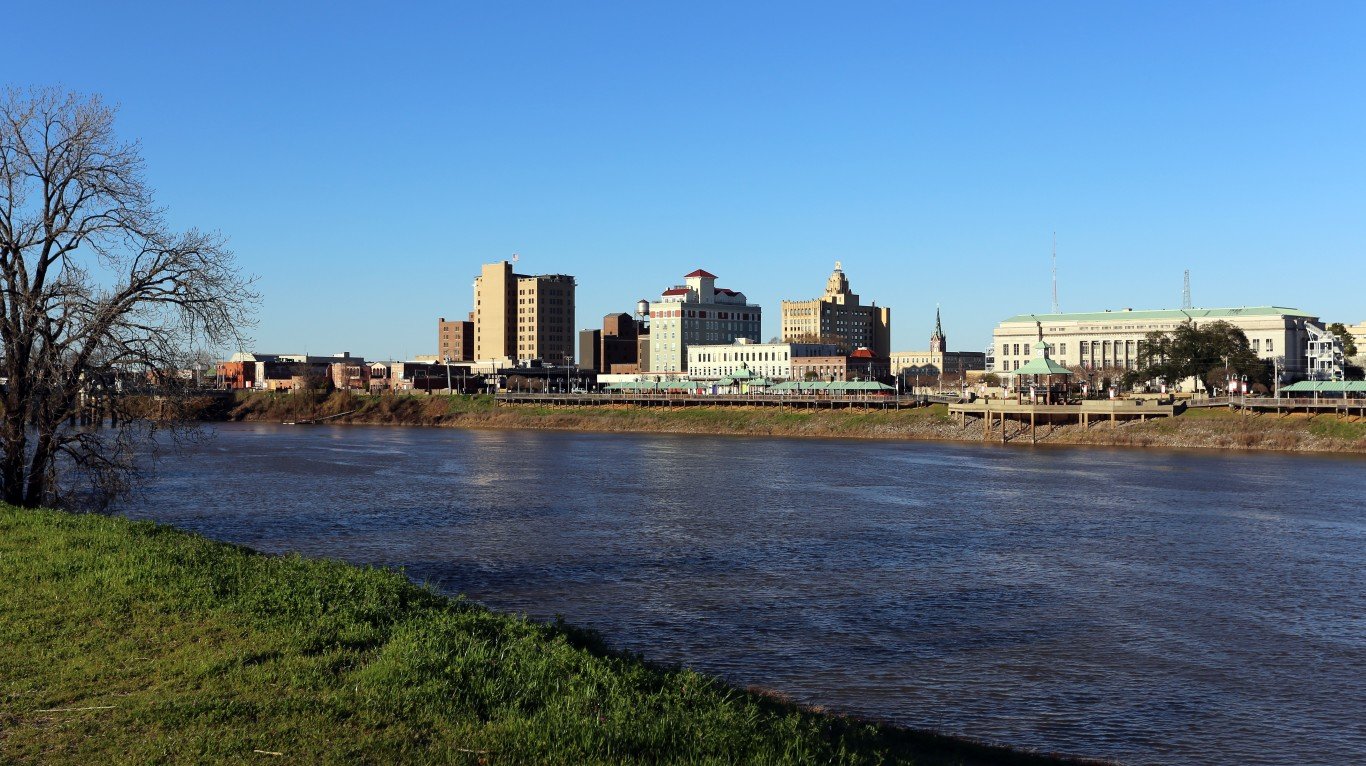
47. Monroe, LA
> Confirmed COVID-19 cases as of Feb. 17: 22,536
> Confirmed COVID-19 cases as of Feb. 17 per 100,000 residents: 11,017.8
> Cumulative COVID-19 deaths as of Feb. 17: 545
> Cumulative COVID-19 deaths as of Feb. 17 per 100,000 residents: 266.4
> Population: 204,542
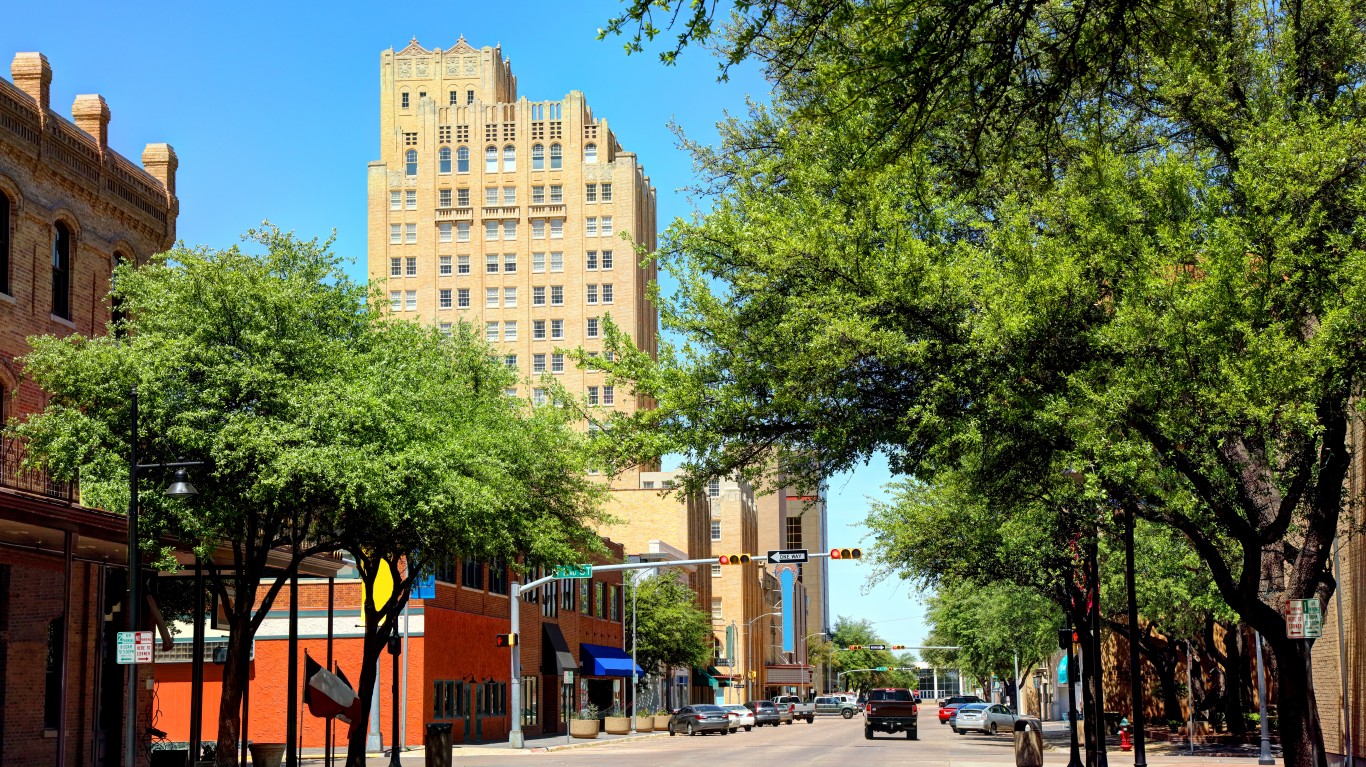
46. Abilene, TX
> Confirmed COVID-19 cases as of Feb. 17: 18,745
> Confirmed COVID-19 cases as of Feb. 17 per 100,000 residents: 11,025.9
> Cumulative COVID-19 deaths as of Feb. 17: 435
> Cumulative COVID-19 deaths as of Feb. 17 per 100,000 residents: 255.9
> Population: 170,009
These are all the counties in Texas where COVID-19 is slowing (and where it’s still getting worse).

45. Sheboygan, WI
> Confirmed COVID-19 cases as of Feb. 17: 12,720
> Confirmed COVID-19 cases as of Feb. 17 per 100,000 residents: 11,041.2
> Cumulative COVID-19 deaths as of Feb. 17: 125
> Cumulative COVID-19 deaths as of Feb. 17 per 100,000 residents: 108.5
> Population: 115,205

44. Hot Springs, AR
> Confirmed COVID-19 cases as of Feb. 17: 10,867
> Confirmed COVID-19 cases as of Feb. 17 per 100,000 residents: 11,055.4
> Cumulative COVID-19 deaths as of Feb. 17: 269
> Cumulative COVID-19 deaths as of Feb. 17 per 100,000 residents: 273.7
> Population: 98,296
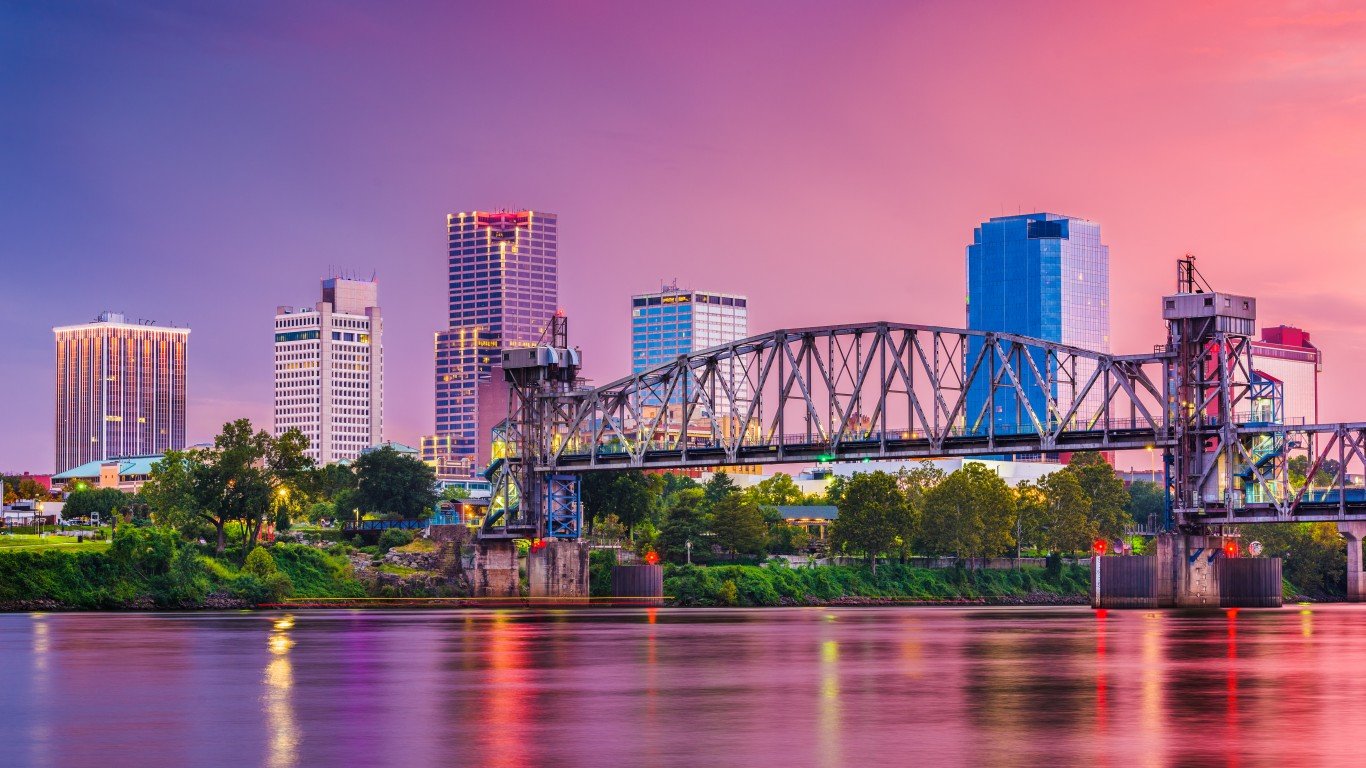
43. Little Rock-North Little Rock-Conway, AR
> Confirmed COVID-19 cases as of Feb. 17: 81,385
> Confirmed COVID-19 cases as of Feb. 17 per 100,000 residents: 11,080.3
> Cumulative COVID-19 deaths as of Feb. 17: 1,160
> Cumulative COVID-19 deaths as of Feb. 17 per 100,000 residents: 157.9
> Population: 734,502
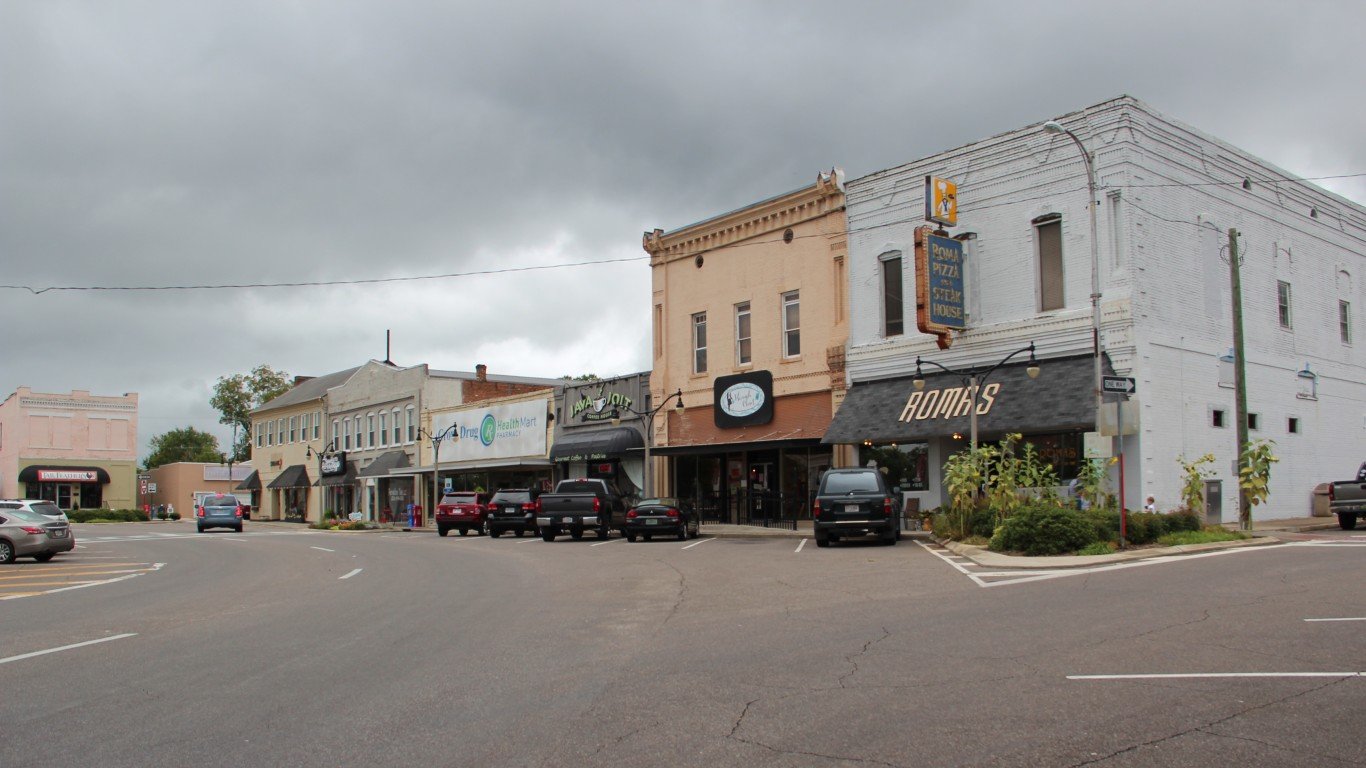
42. Anniston-Oxford, AL
> Confirmed COVID-19 cases as of Feb. 17: 12,784
> Confirmed COVID-19 cases as of Feb. 17 per 100,000 residents: 11,107.1
> Cumulative COVID-19 deaths as of Feb. 17: 264
> Cumulative COVID-19 deaths as of Feb. 17 per 100,000 residents: 229.4
> Population: 115,098

41. Rapid City, SD
> Confirmed COVID-19 cases as of Feb. 17: 15,188
> Confirmed COVID-19 cases as of Feb. 17 per 100,000 residents: 11,109.0
> Cumulative COVID-19 deaths as of Feb. 17: 215
> Cumulative COVID-19 deaths as of Feb. 17 per 100,000 residents: 157.3
> Population: 136,718
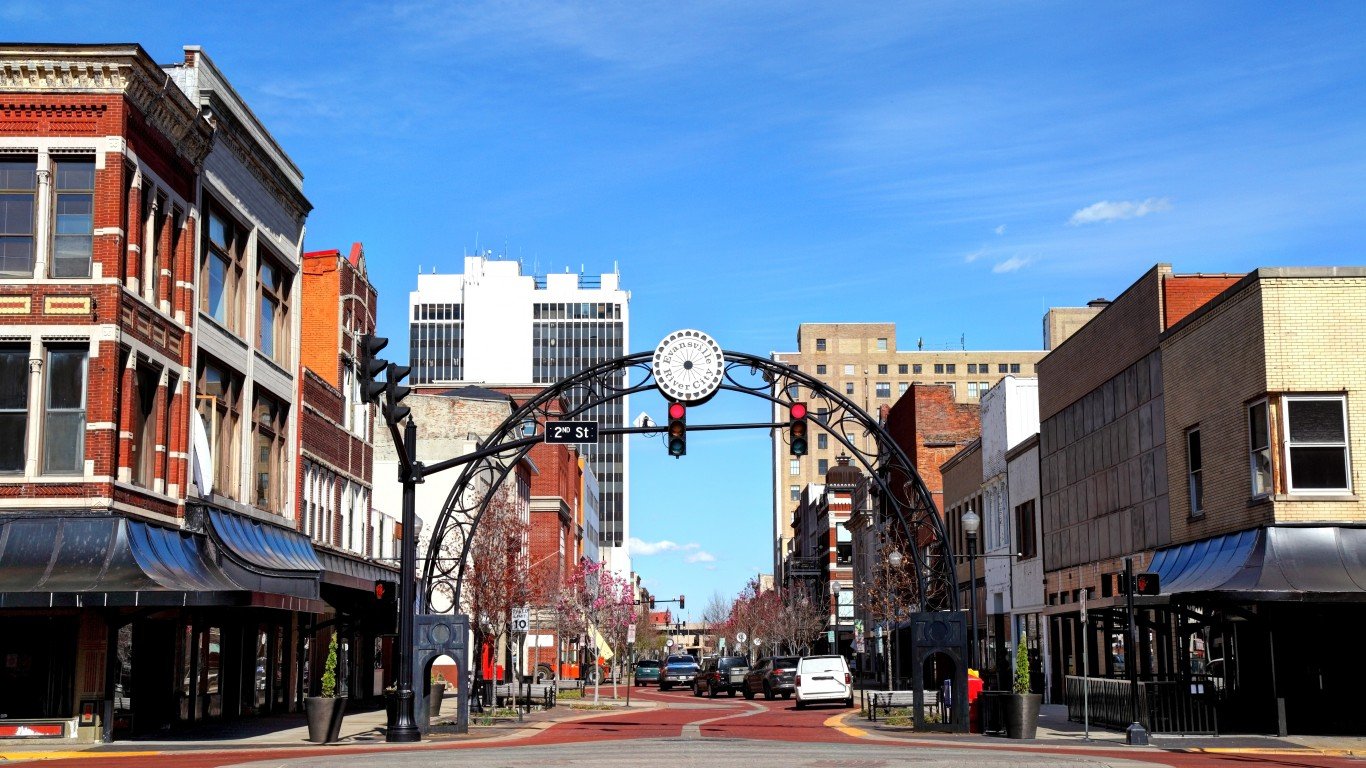
40. Evansville, IN-KY
> Confirmed COVID-19 cases as of Feb. 17: 35,104
> Confirmed COVID-19 cases as of Feb. 17 per 100,000 residents: 11,145.3
> Cumulative COVID-19 deaths as of Feb. 17: 595
> Cumulative COVID-19 deaths as of Feb. 17 per 100,000 residents: 188.9
> Population: 314,967

39. Morristown, TN
> Confirmed COVID-19 cases as of Feb. 17: 15,711
> Confirmed COVID-19 cases as of Feb. 17 per 100,000 residents: 11,222.1
> Cumulative COVID-19 deaths as of Feb. 17: 314
> Cumulative COVID-19 deaths as of Feb. 17 per 100,000 residents: 224.3
> Population: 140,000
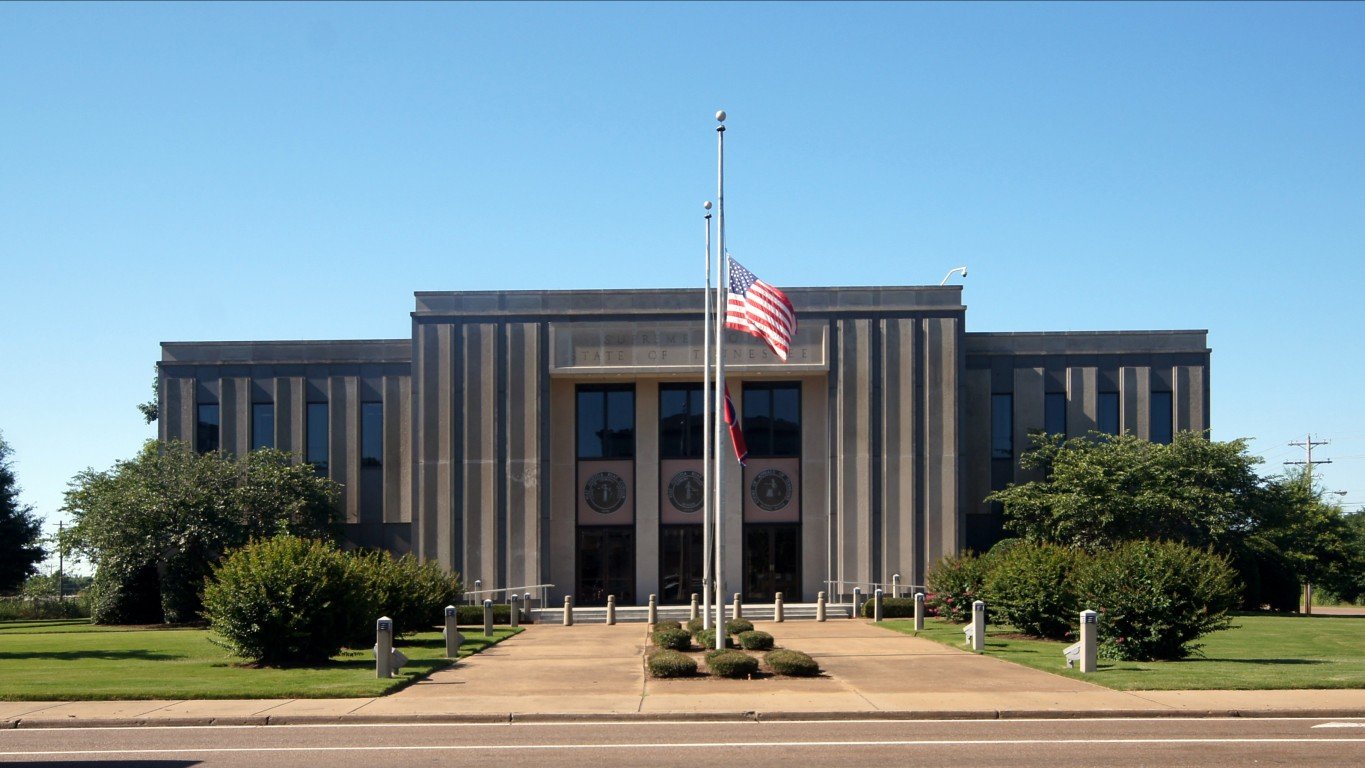
38. Jackson, TN
> Confirmed COVID-19 cases as of Feb. 17: 20,061
> Confirmed COVID-19 cases as of Feb. 17 per 100,000 residents: 11,238.3
> Cumulative COVID-19 deaths as of Feb. 17: 452
> Cumulative COVID-19 deaths as of Feb. 17 per 100,000 residents: 253.2
> Population: 178,506

37. Spartanburg, SC
> Confirmed COVID-19 cases as of Feb. 17: 34,085
> Confirmed COVID-19 cases as of Feb. 17 per 100,000 residents: 11,279.1
> Cumulative COVID-19 deaths as of Feb. 17: 659
> Cumulative COVID-19 deaths as of Feb. 17 per 100,000 residents: 218.1
> Population: 302,195
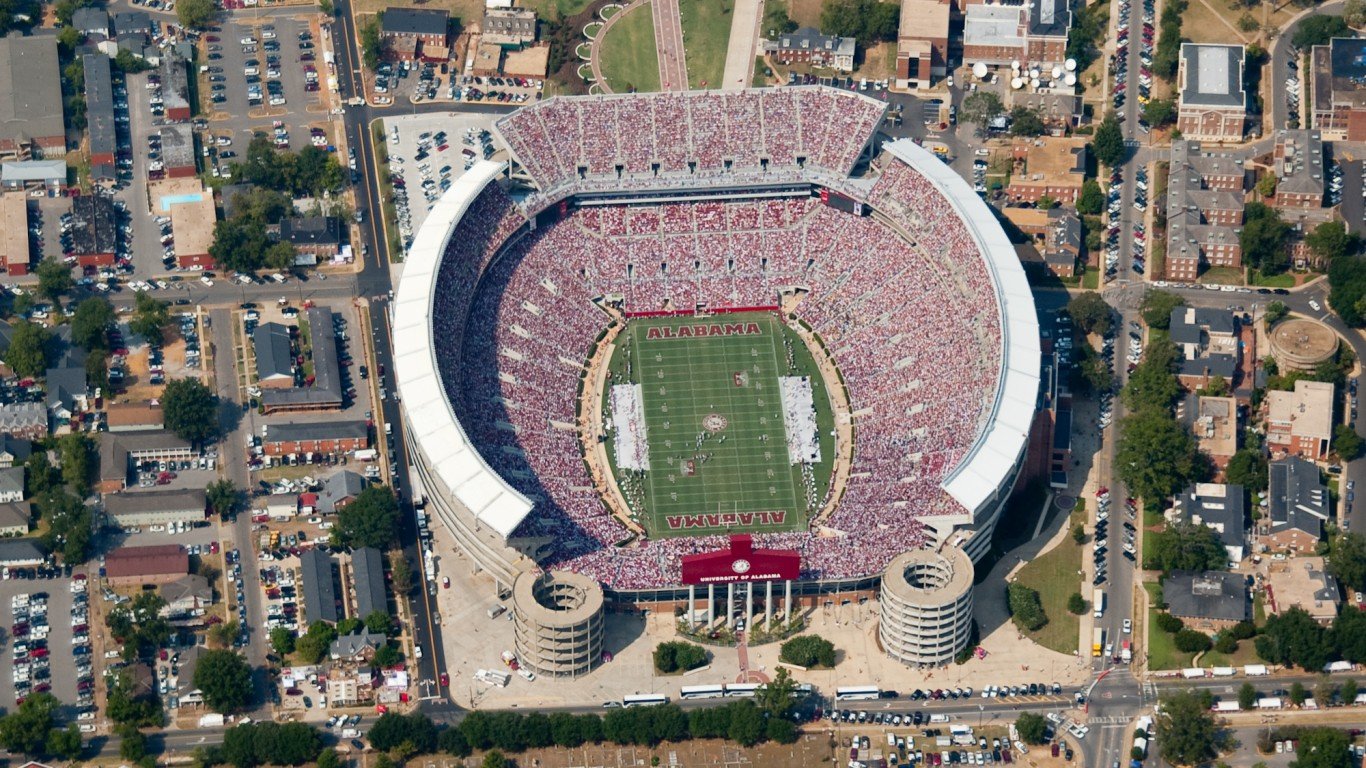
36. Tuscaloosa, AL
> Confirmed COVID-19 cases as of Feb. 17: 28,646
> Confirmed COVID-19 cases as of Feb. 17 per 100,000 residents: 11,466.5
> Cumulative COVID-19 deaths as of Feb. 17: 538
> Cumulative COVID-19 deaths as of Feb. 17 per 100,000 residents: 215.4
> Population: 249,824

35. Flagstaff, AZ
> Confirmed COVID-19 cases as of Feb. 17: 16,088
> Confirmed COVID-19 cases as of Feb. 17 per 100,000 residents: 11,473.6
> Cumulative COVID-19 deaths as of Feb. 17: 302
> Cumulative COVID-19 deaths as of Feb. 17 per 100,000 residents: 215.4
> Population: 140,217
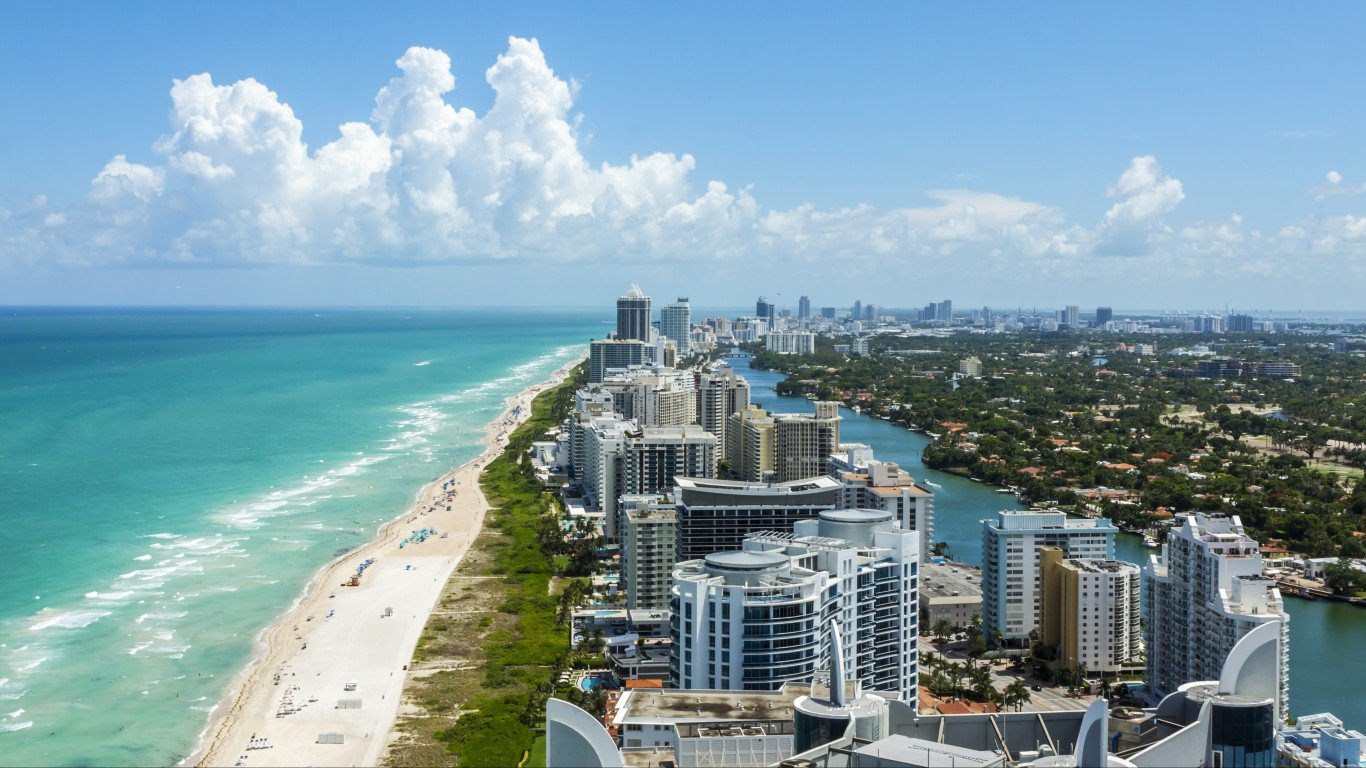
34. Miami-Fort Lauderdale-Pompano Beach, FL
> Confirmed COVID-19 cases as of Feb. 17: 699,851
> Confirmed COVID-19 cases as of Feb. 17 per 100,000 residents: 11,527.9
> Cumulative COVID-19 deaths as of Feb. 17: 9,874
> Cumulative COVID-19 deaths as of Feb. 17 per 100,000 residents: 162.6
> Population: 6,070,944
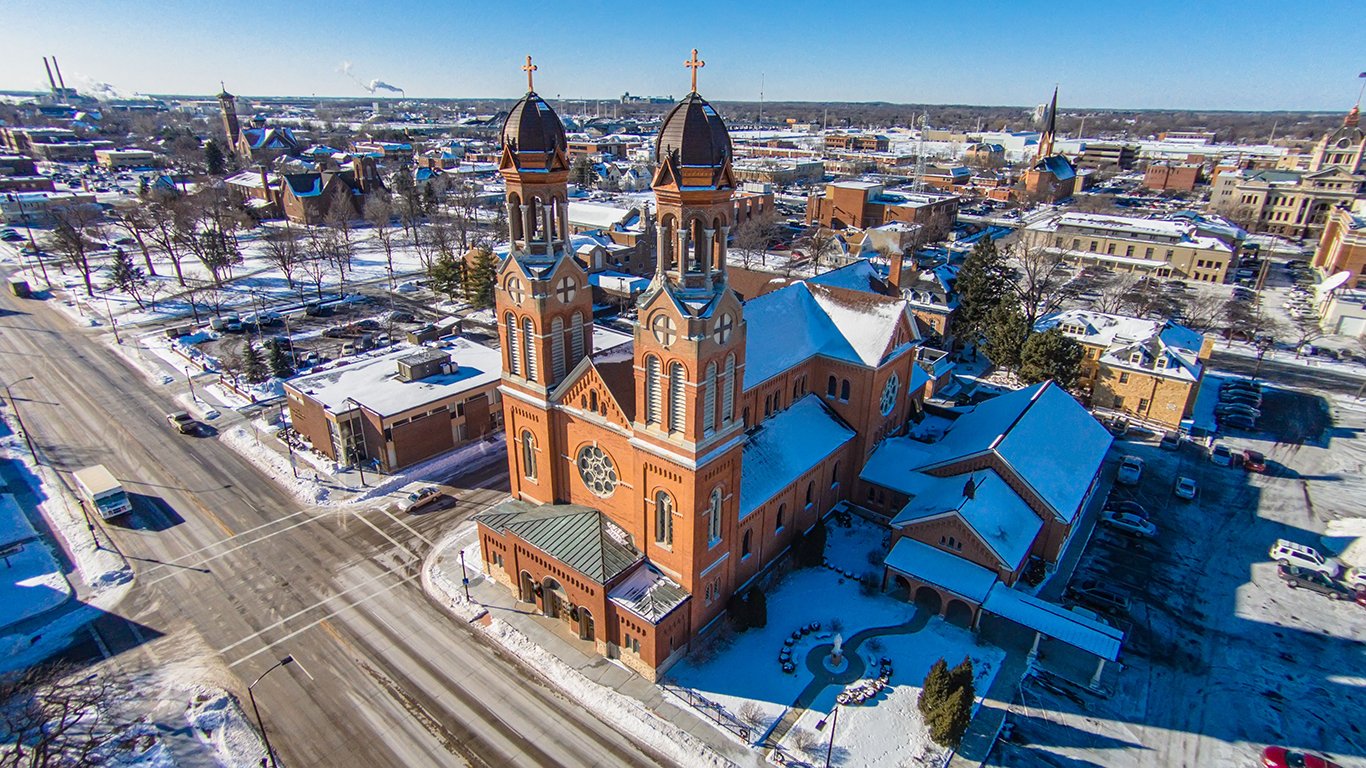
33. Green Bay, WI
> Confirmed COVID-19 cases as of Feb. 17: 36,632
> Confirmed COVID-19 cases as of Feb. 17 per 100,000 residents: 11,530.3
> Cumulative COVID-19 deaths as of Feb. 17: 277
> Cumulative COVID-19 deaths as of Feb. 17 per 100,000 residents: 87.2
> Population: 317,702
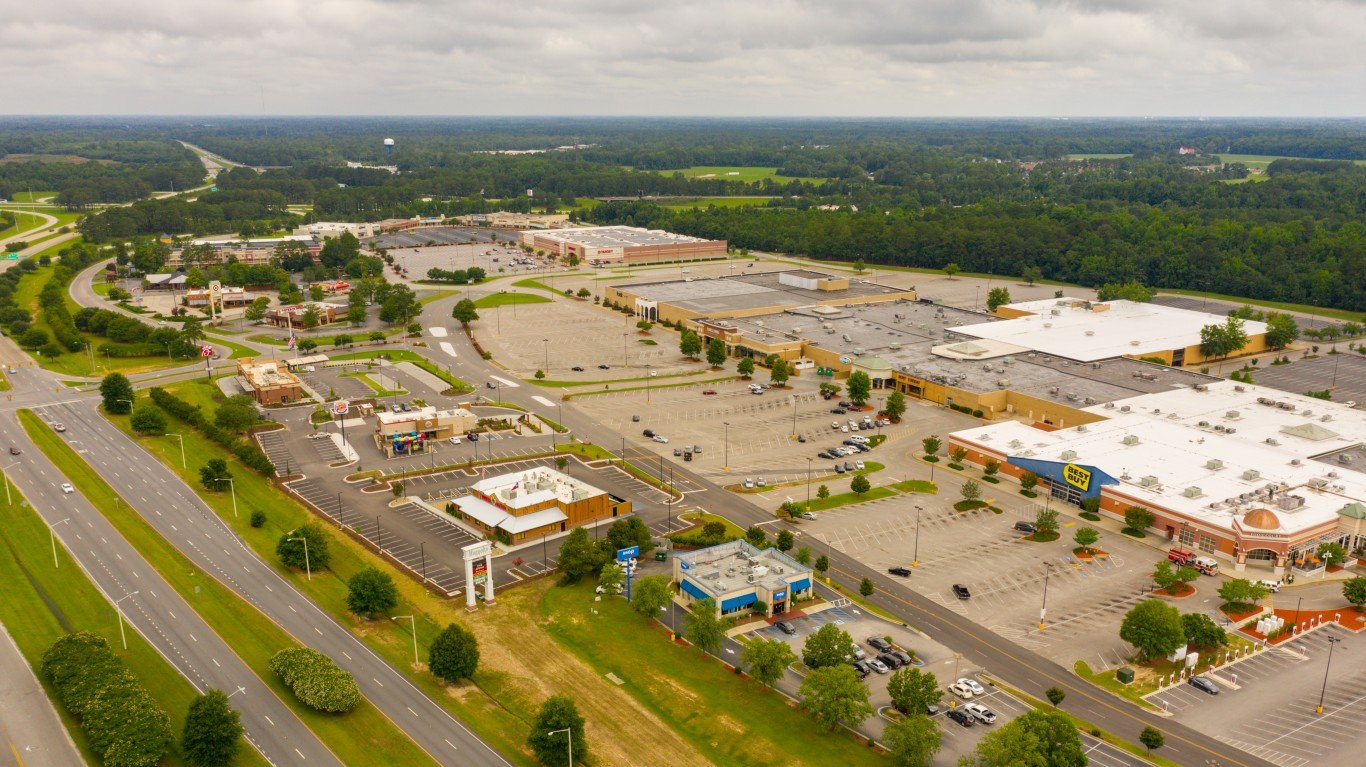
32. Florence, SC
> Confirmed COVID-19 cases as of Feb. 17: 23,787
> Confirmed COVID-19 cases as of Feb. 17 per 100,000 residents: 11,557.5
> Cumulative COVID-19 deaths as of Feb. 17: 528
> Cumulative COVID-19 deaths as of Feb. 17 per 100,000 residents: 256.5
> Population: 205,814

31. Fond du Lac, WI
> Confirmed COVID-19 cases as of Feb. 17: 11,838
> Confirmed COVID-19 cases as of Feb. 17 per 100,000 residents: 11,570.2
> Cumulative COVID-19 deaths as of Feb. 17: 89
> Cumulative COVID-19 deaths as of Feb. 17 per 100,000 residents: 87
> Population: 102,315
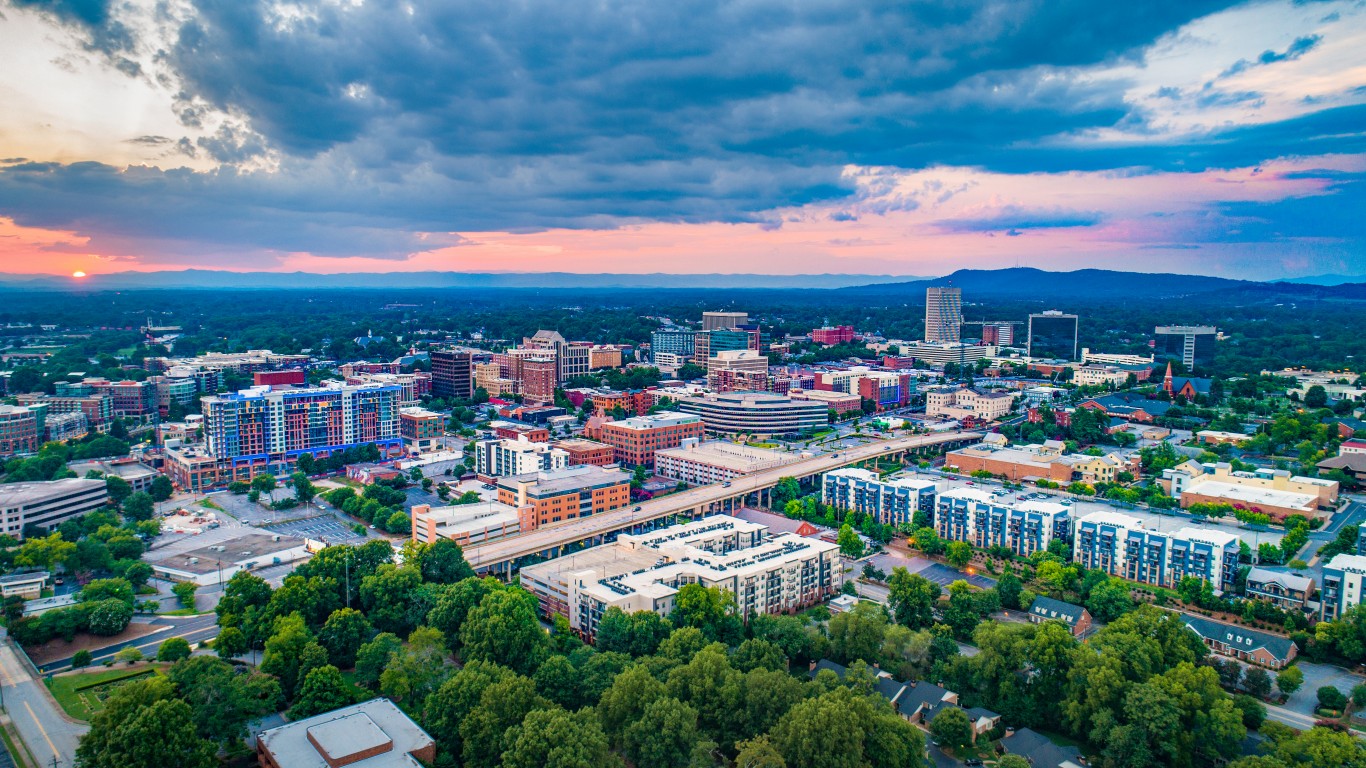
30. Greenville-Anderson, SC
> Confirmed COVID-19 cases as of Feb. 17: 102,511
> Confirmed COVID-19 cases as of Feb. 17 per 100,000 residents: 11,598.2
> Cumulative COVID-19 deaths as of Feb. 17: 1,653
> Cumulative COVID-19 deaths as of Feb. 17 per 100,000 residents: 187
> Population: 883,853

29. St. Cloud, MN
> Confirmed COVID-19 cases as of Feb. 17: 22,952
> Confirmed COVID-19 cases as of Feb. 17 per 100,000 residents: 11,674.6
> Cumulative COVID-19 deaths as of Feb. 17: 289
> Cumulative COVID-19 deaths as of Feb. 17 per 100,000 residents: 147
> Population: 196,598
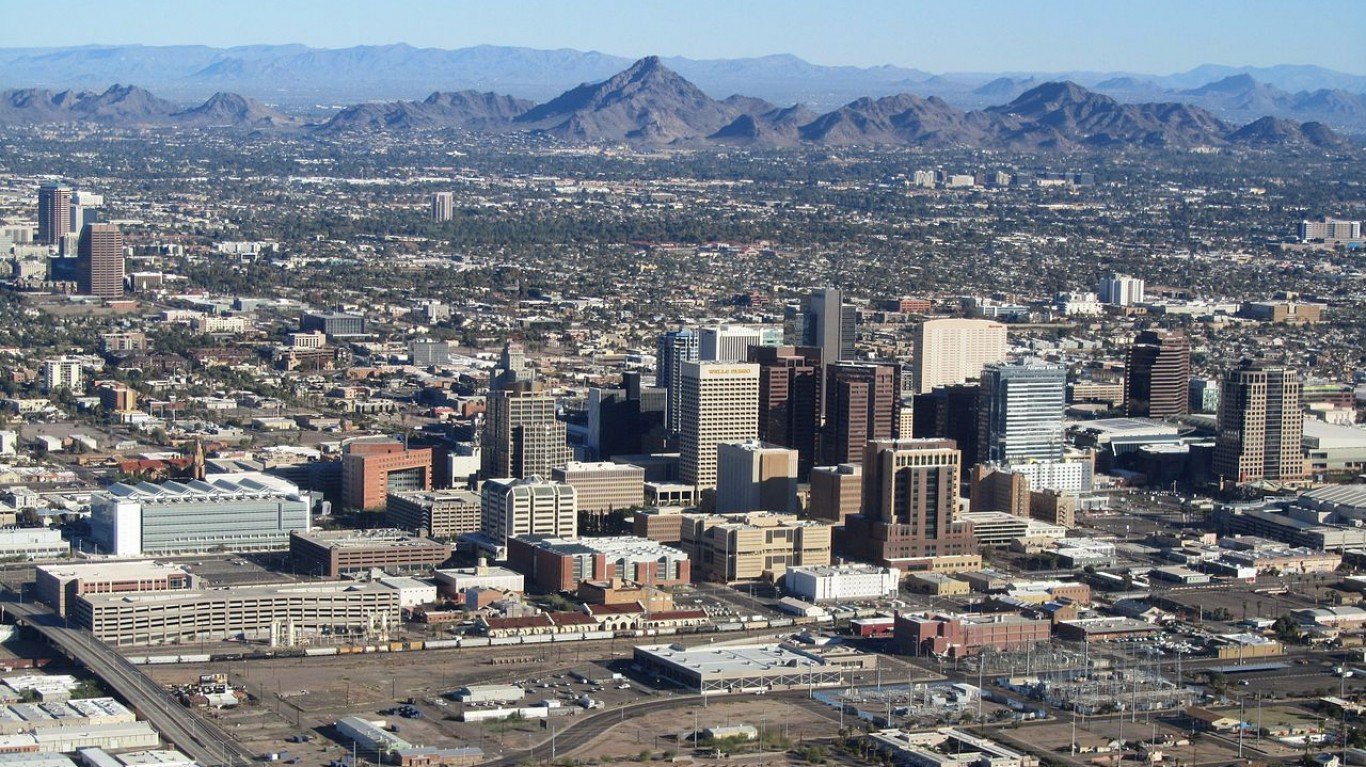
28. Phoenix-Mesa-Chandler, AZ
> Confirmed COVID-19 cases as of Feb. 17: 545,650
> Confirmed COVID-19 cases as of Feb. 17 per 100,000 residents: 11,675.1
> Cumulative COVID-19 deaths as of Feb. 17: 9,273
> Cumulative COVID-19 deaths as of Feb. 17 per 100,000 residents: 198.4
> Population: 4,673,634
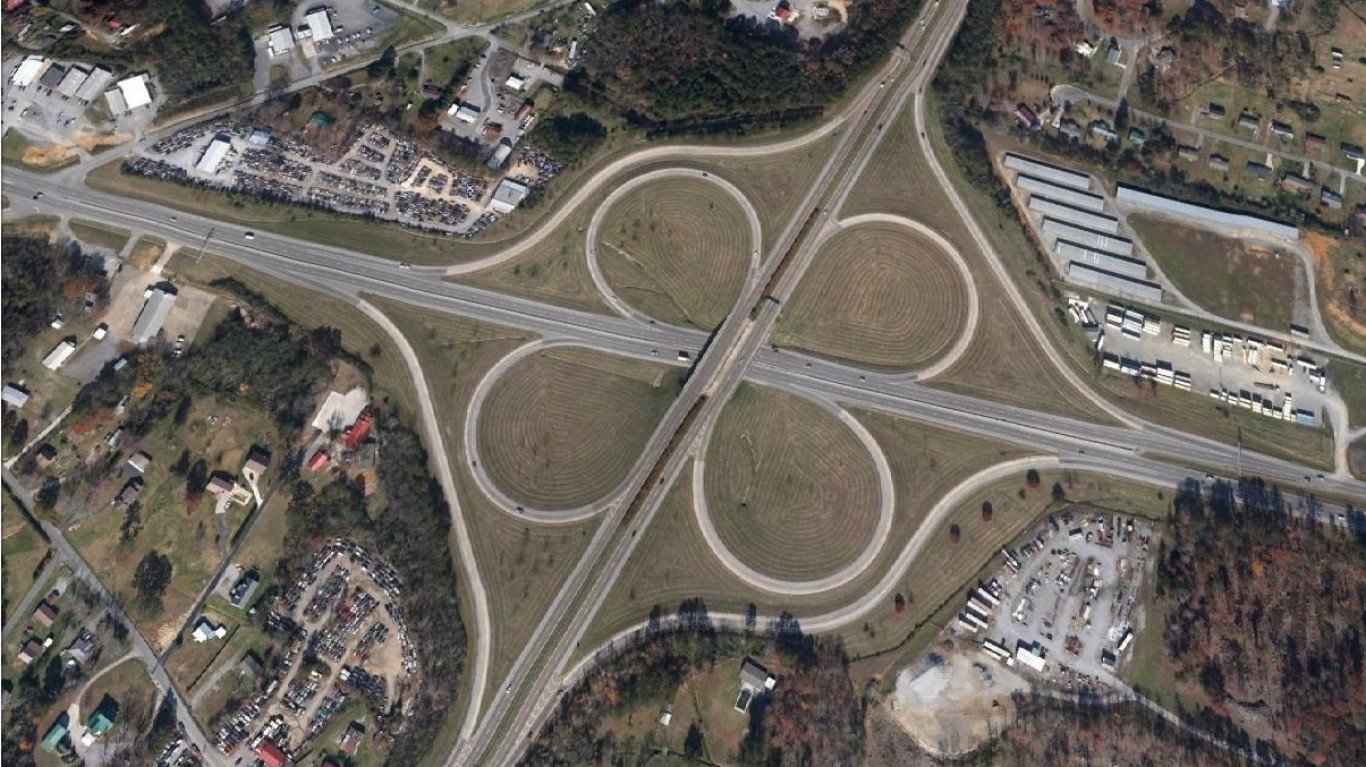
27. Cleveland, TN
> Confirmed COVID-19 cases as of Feb. 17: 14,204
> Confirmed COVID-19 cases as of Feb. 17 per 100,000 residents: 11,706.0
> Cumulative COVID-19 deaths as of Feb. 17: 153
> Cumulative COVID-19 deaths as of Feb. 17 per 100,000 residents: 126.1
> Population: 121,339
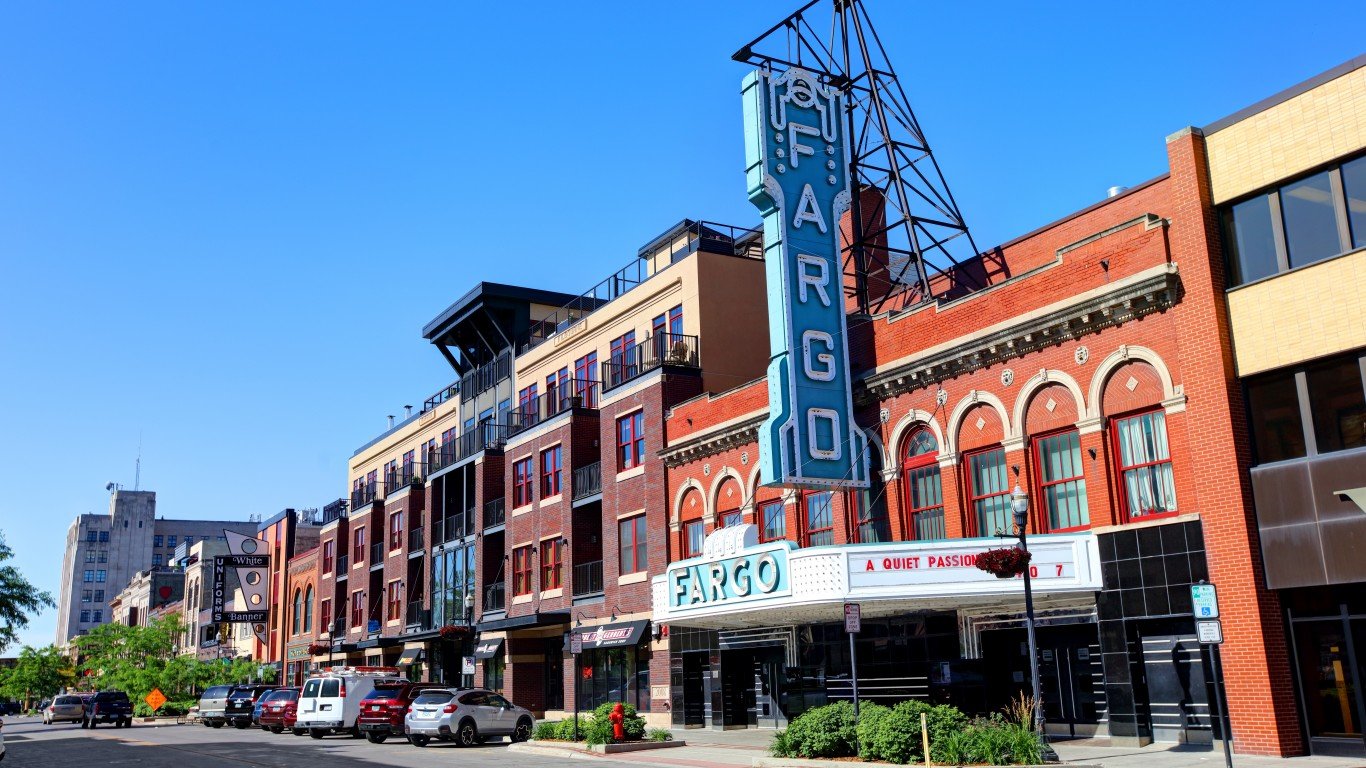
26. Fargo, ND-MN
> Confirmed COVID-19 cases as of Feb. 17: 27,948
> Confirmed COVID-19 cases as of Feb. 17 per 100,000 residents: 11,792.3
> Cumulative COVID-19 deaths as of Feb. 17: 276
> Cumulative COVID-19 deaths as of Feb. 17 per 100,000 residents: 116.5
> Population: 237,003

25. Nashville-Davidson–Murfreesboro–Franklin, TN
> Confirmed COVID-19 cases as of Feb. 17: 219,485
> Confirmed COVID-19 cases as of Feb. 17 per 100,000 residents: 11,932.0
> Cumulative COVID-19 deaths as of Feb. 17: 2,459
> Cumulative COVID-19 deaths as of Feb. 17 per 100,000 residents: 133.7
> Population: 1,839,460
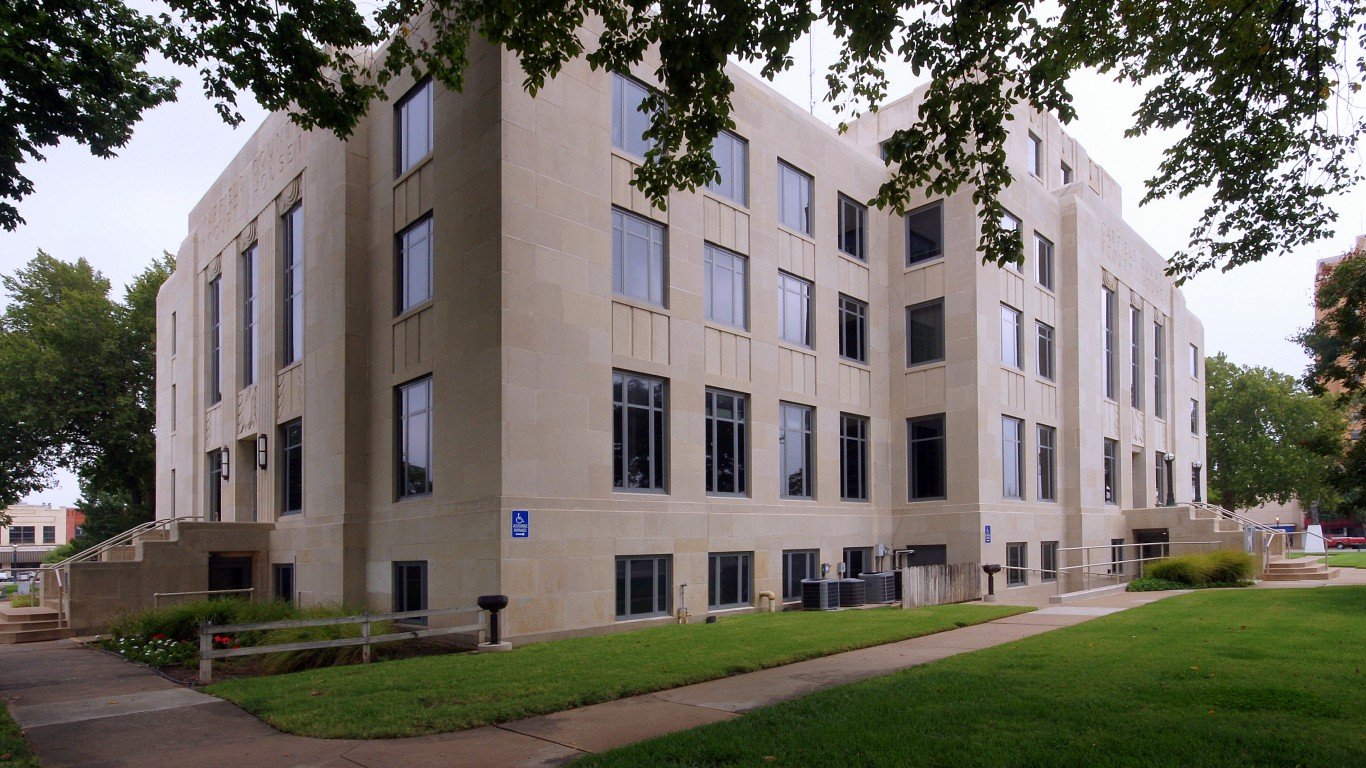
24. Enid, OK
> Confirmed COVID-19 cases as of Feb. 17: 7,421
> Confirmed COVID-19 cases as of Feb. 17 per 100,000 residents: 11,932.8
> Cumulative COVID-19 deaths as of Feb. 17: 69
> Cumulative COVID-19 deaths as of Feb. 17 per 100,000 residents: 111
> Population: 62,190

23. Salt Lake City, UT
> Confirmed COVID-19 cases as of Feb. 17: 142,315
> Confirmed COVID-19 cases as of Feb. 17 per 100,000 residents: 11,999.7
> Cumulative COVID-19 deaths as of Feb. 17: 749
> Cumulative COVID-19 deaths as of Feb. 17 per 100,000 residents: 63.2
> Population: 1,185,990
These are all the counties in Utah where COVID-19 is slowing (and where it’s still getting worse).
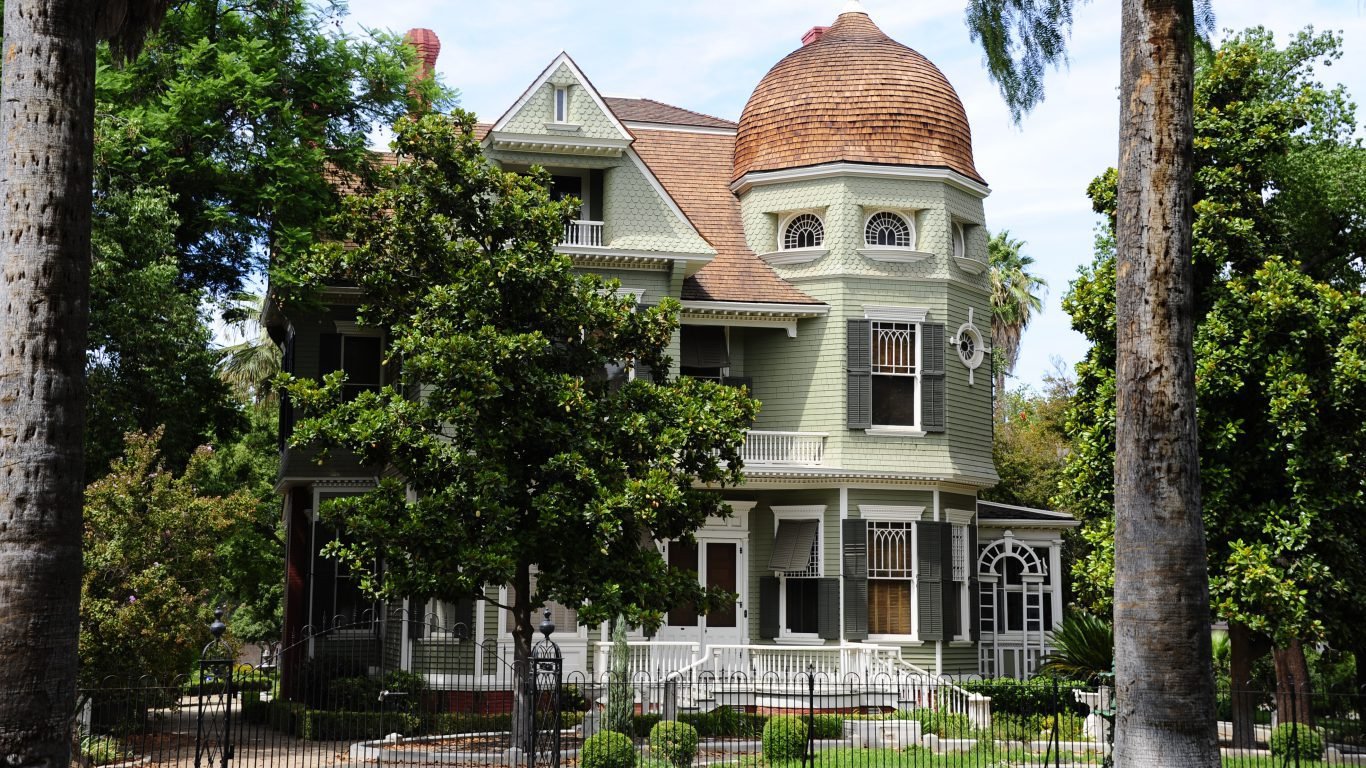
22. Riverside-San Bernardino-Ontario, CA
> Confirmed COVID-19 cases as of Feb. 17: 553,901
> Confirmed COVID-19 cases as of Feb. 17 per 100,000 residents: 12,258.0
> Cumulative COVID-19 deaths as of Feb. 17: 5,976
> Cumulative COVID-19 deaths as of Feb. 17 per 100,000 residents: 132.3
> Population: 4,518,699
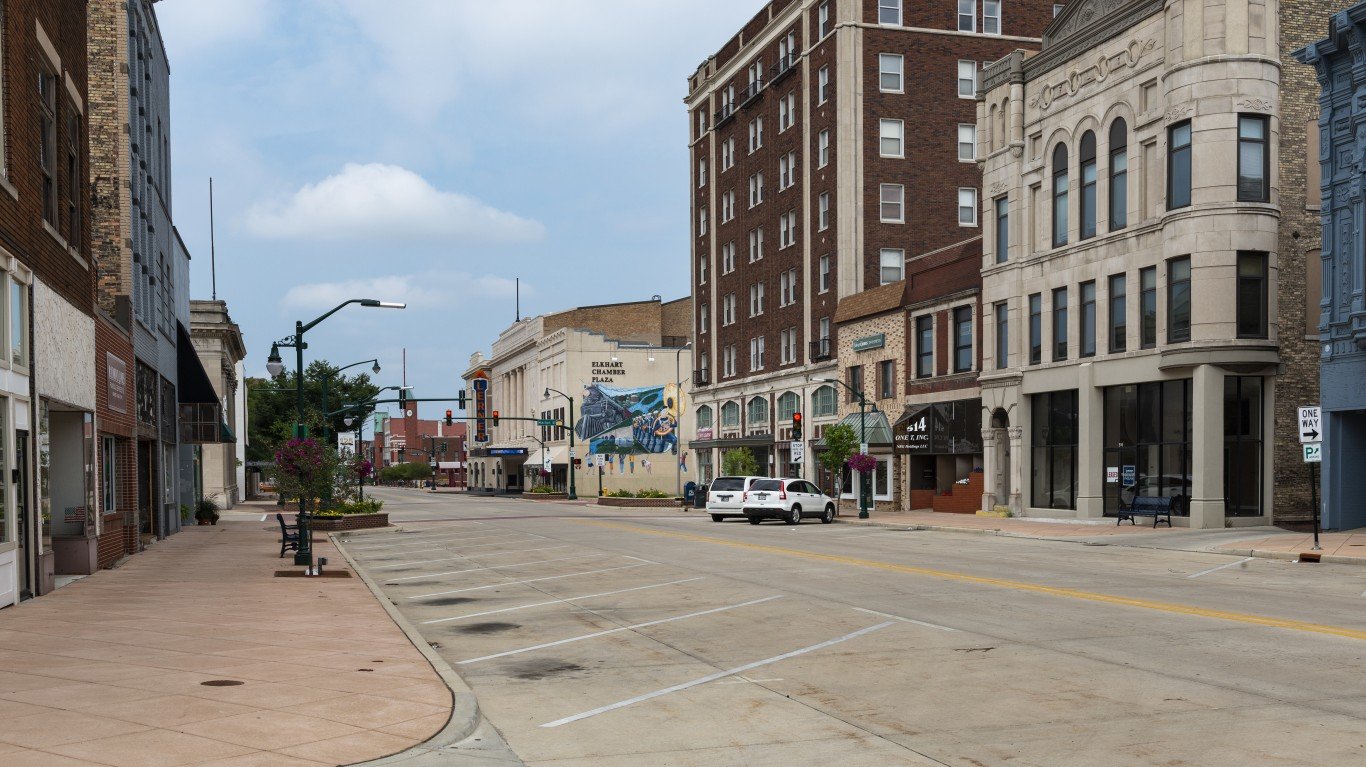
21. Elkhart-Goshen, IN
> Confirmed COVID-19 cases as of Feb. 17: 25,121
> Confirmed COVID-19 cases as of Feb. 17 per 100,000 residents: 12,338.2
> Cumulative COVID-19 deaths as of Feb. 17: 406
> Cumulative COVID-19 deaths as of Feb. 17 per 100,000 residents: 199.4
> Population: 203,604
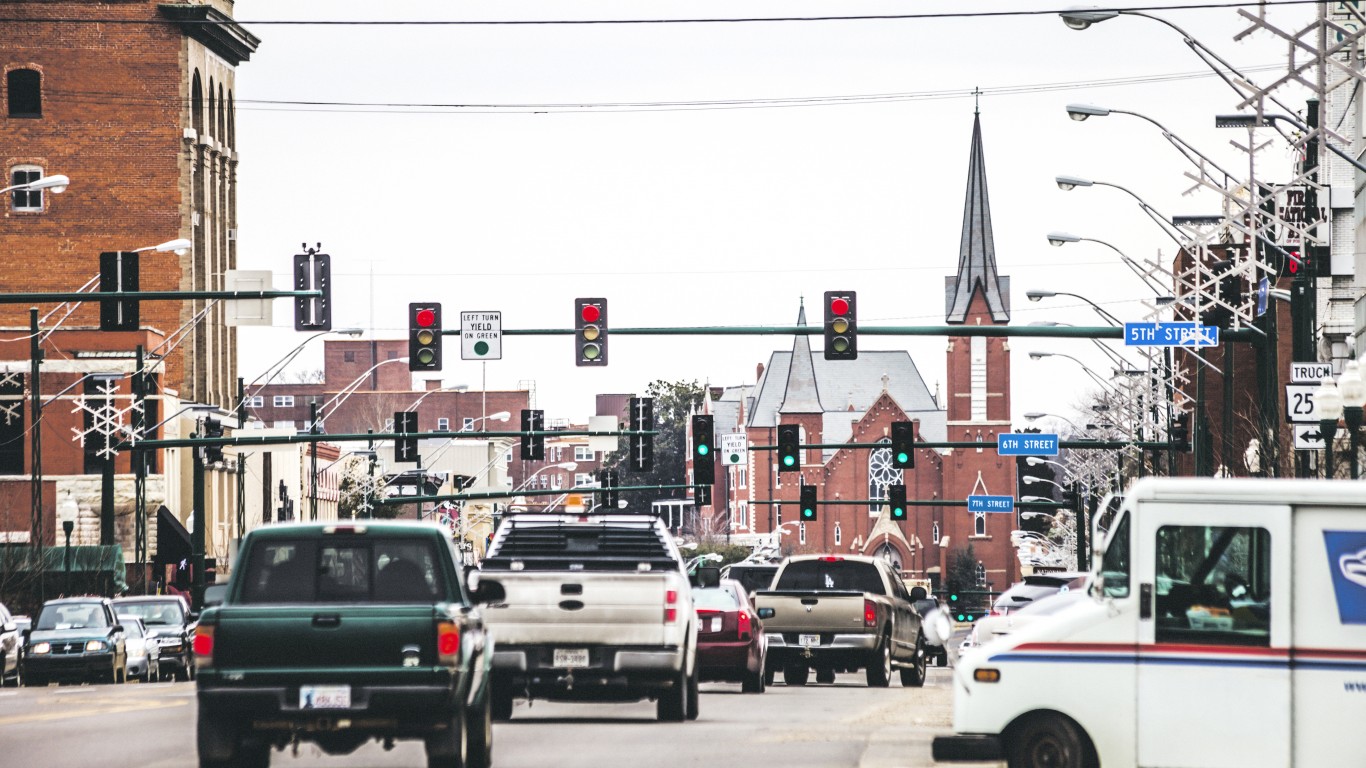
20. Fort Smith, AR-OK
> Confirmed COVID-19 cases as of Feb. 17: 31,195
> Confirmed COVID-19 cases as of Feb. 17 per 100,000 residents: 12,524.5
> Cumulative COVID-19 deaths as of Feb. 17: 474
> Cumulative COVID-19 deaths as of Feb. 17 per 100,000 residents: 190.3
> Population: 249,072

19. Dubuque, IA
> Confirmed COVID-19 cases as of Feb. 17: 12,155
> Confirmed COVID-19 cases as of Feb. 17 per 100,000 residents: 12,556.6
> Cumulative COVID-19 deaths as of Feb. 17: 190
> Cumulative COVID-19 deaths as of Feb. 17 per 100,000 residents: 196.3
> Population: 96,802
These are all the counties in Iowa where COVID-19 is slowing (and where it’s still getting worse).
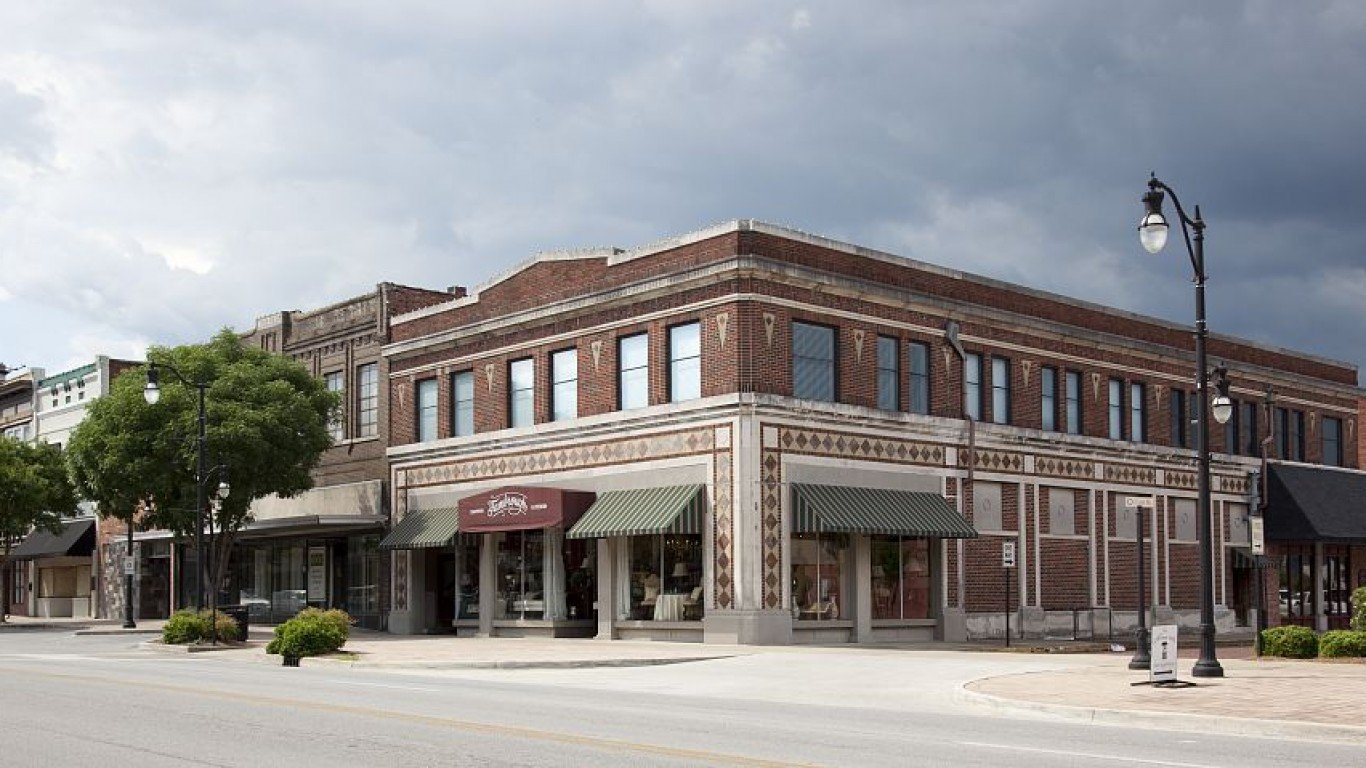
18. Gadsden, AL
> Confirmed COVID-19 cases as of Feb. 17: 12,995
> Confirmed COVID-19 cases as of Feb. 17 per 100,000 residents: 12,624.0
> Cumulative COVID-19 deaths as of Feb. 17: 300
> Cumulative COVID-19 deaths as of Feb. 17 per 100,000 residents: 291.4
> Population: 102,939

17. Amarillo, TX
> Confirmed COVID-19 cases as of Feb. 17: 33,544
> Confirmed COVID-19 cases as of Feb. 17 per 100,000 residents: 12,734.4
> Cumulative COVID-19 deaths as of Feb. 17: 632
> Cumulative COVID-19 deaths as of Feb. 17 per 100,000 residents: 239.9
> Population: 263,412
These are all the counties in Texas where COVID-19 is slowing (and where it’s still getting worse).

16. Gainesville, GA
> Confirmed COVID-19 cases as of Feb. 17: 24,993
> Confirmed COVID-19 cases as of Feb. 17 per 100,000 residents: 12,754.1
> Cumulative COVID-19 deaths as of Feb. 17: 379
> Cumulative COVID-19 deaths as of Feb. 17 per 100,000 residents: 193.4
> Population: 195,961

15. Grand Forks, ND-MN
> Confirmed COVID-19 cases as of Feb. 17: 13,123
> Confirmed COVID-19 cases as of Feb. 17 per 100,000 residents: 12,866.8
> Cumulative COVID-19 deaths as of Feb. 17: 135
> Cumulative COVID-19 deaths as of Feb. 17 per 100,000 residents: 132.4
> Population: 101,991
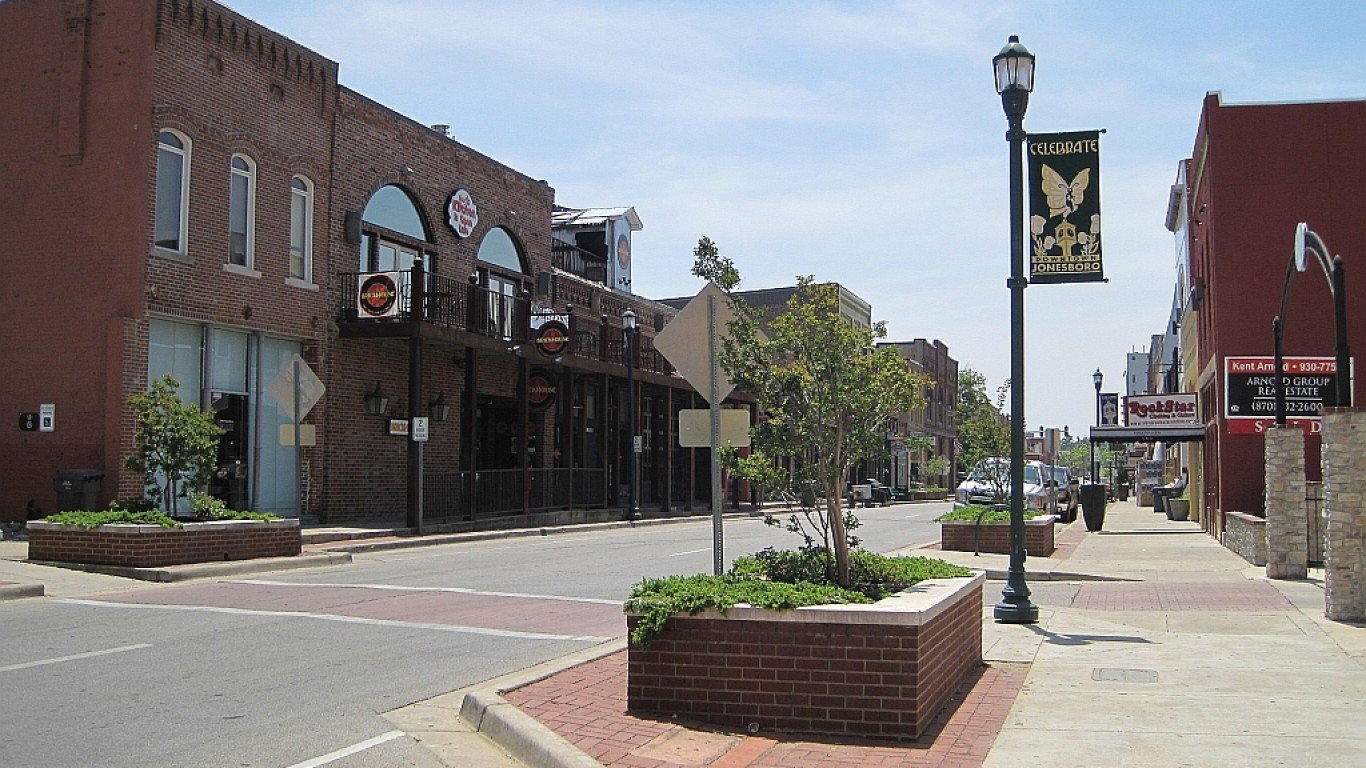
14. Jonesboro, AR
> Confirmed COVID-19 cases as of Feb. 17: 17,693
> Confirmed COVID-19 cases as of Feb. 17 per 100,000 residents: 13,635.7
> Cumulative COVID-19 deaths as of Feb. 17: 284
> Cumulative COVID-19 deaths as of Feb. 17 per 100,000 residents: 218.9
> Population: 129,755
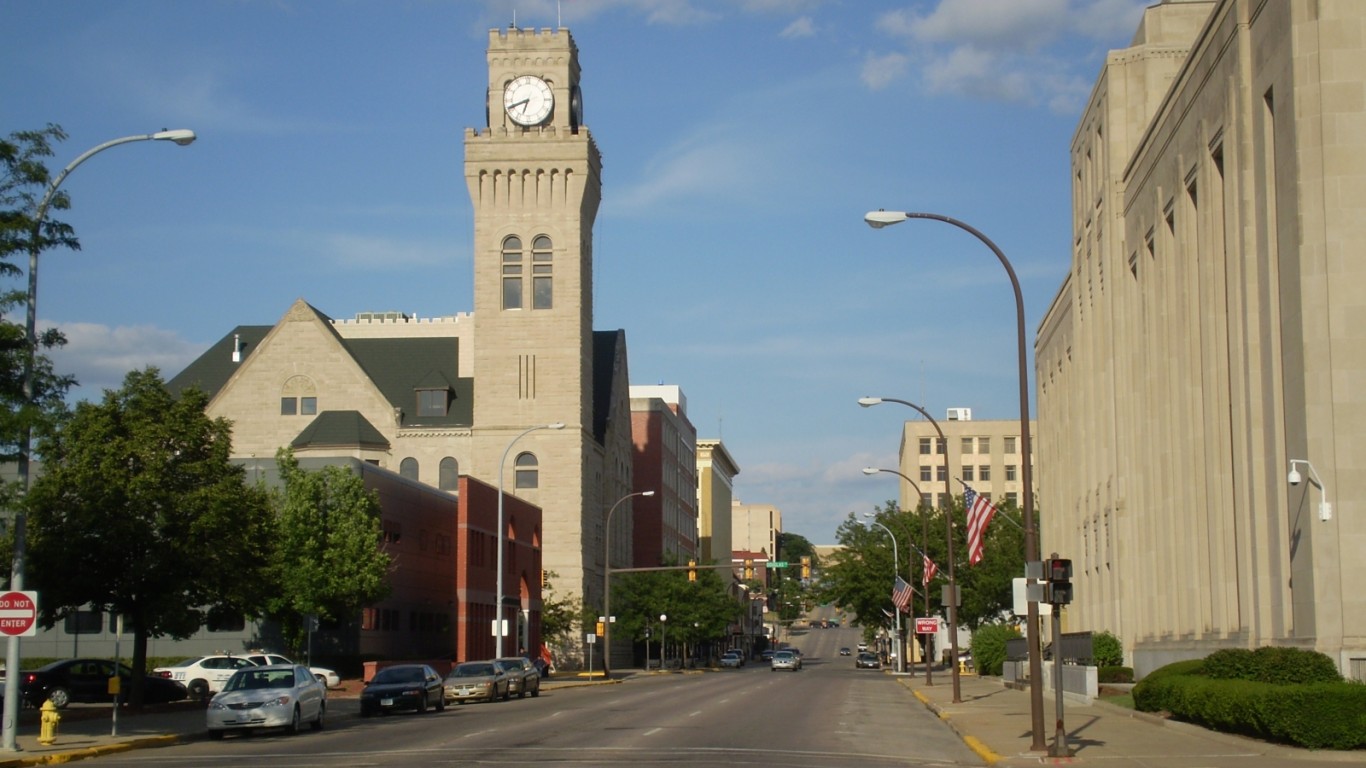
13. Sioux City, IA-NE-SD
> Confirmed COVID-19 cases as of Feb. 17: 19,712
> Confirmed COVID-19 cases as of Feb. 17 per 100,000 residents: 13,723.4
> Cumulative COVID-19 deaths as of Feb. 17: 312
> Cumulative COVID-19 deaths as of Feb. 17 per 100,000 residents: 217.2
> Population: 143,638
These are all the counties in Iowa where COVID-19 is slowing (and where it’s still getting worse).

12. Dalton, GA
> Confirmed COVID-19 cases as of Feb. 17: 19,994
> Confirmed COVID-19 cases as of Feb. 17 per 100,000 residents: 13,942.2
> Cumulative COVID-19 deaths as of Feb. 17: 272
> Cumulative COVID-19 deaths as of Feb. 17 per 100,000 residents: 189.7
> Population: 143,406

11. Fayetteville-Springdale-Rogers, AR
> Confirmed COVID-19 cases as of Feb. 17: 70,332
> Confirmed COVID-19 cases as of Feb. 17 per 100,000 residents: 13,966.3
> Cumulative COVID-19 deaths as of Feb. 17: 929
> Cumulative COVID-19 deaths as of Feb. 17 per 100,000 residents: 184.5
> Population: 503,585

10. El Paso, TX
> Confirmed COVID-19 cases as of Feb. 17: 120,205
> Confirmed COVID-19 cases as of Feb. 17 per 100,000 residents: 14,350.2
> Cumulative COVID-19 deaths as of Feb. 17: 2,262
> Cumulative COVID-19 deaths as of Feb. 17 per 100,000 residents: 270
> Population: 837,654
These are all the counties in Texas where COVID-19 is slowing (and where it’s still getting worse).
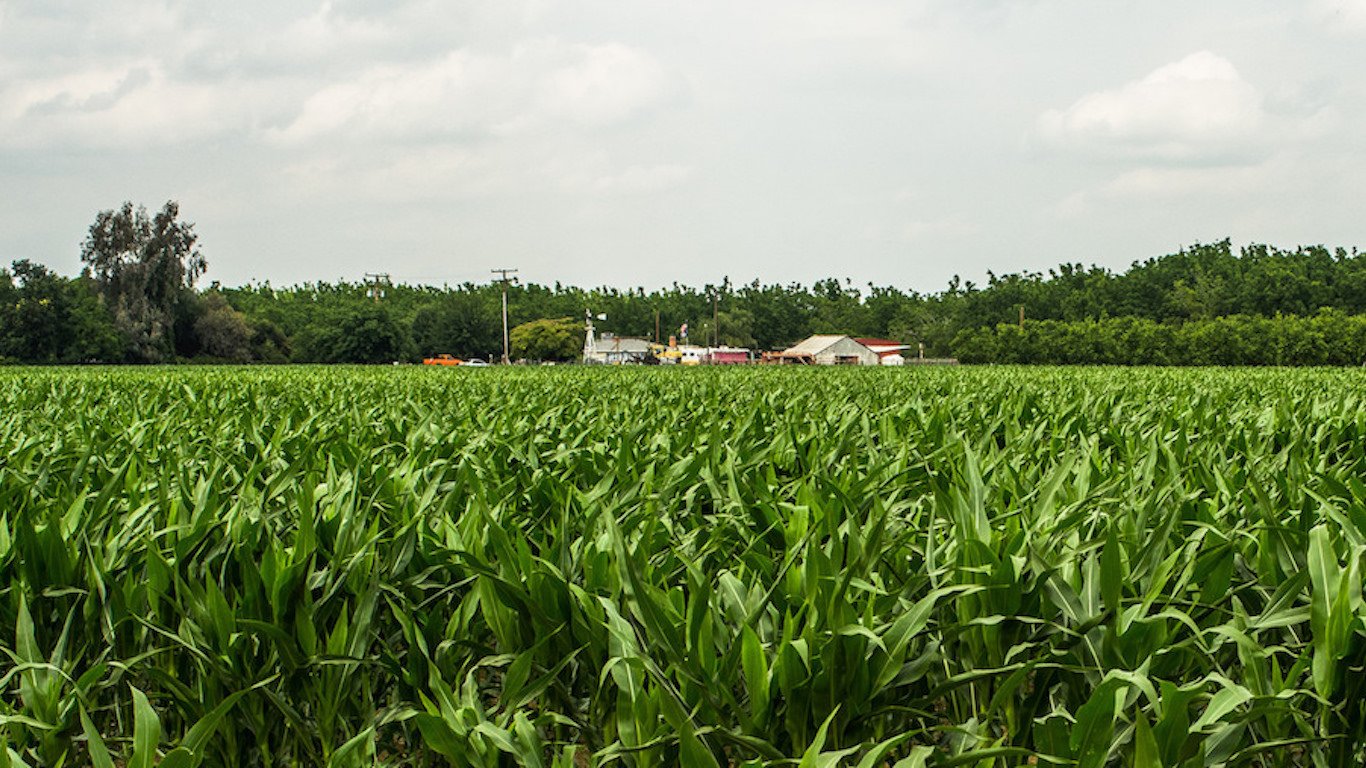
9. Hanford-Corcoran, CA
> Confirmed COVID-19 cases as of Feb. 17: 21,583
> Confirmed COVID-19 cases as of Feb. 17 per 100,000 residents: 14,381.5
> Cumulative COVID-19 deaths as of Feb. 17: 209
> Cumulative COVID-19 deaths as of Feb. 17 per 100,000 residents: 139.3
> Population: 150,075

8. Sioux Falls, SD
> Confirmed COVID-19 cases as of Feb. 17: 36,969
> Confirmed COVID-19 cases as of Feb. 17 per 100,000 residents: 14,472.8
> Cumulative COVID-19 deaths as of Feb. 17: 476
> Cumulative COVID-19 deaths as of Feb. 17 per 100,000 residents: 186.3
> Population: 255,438
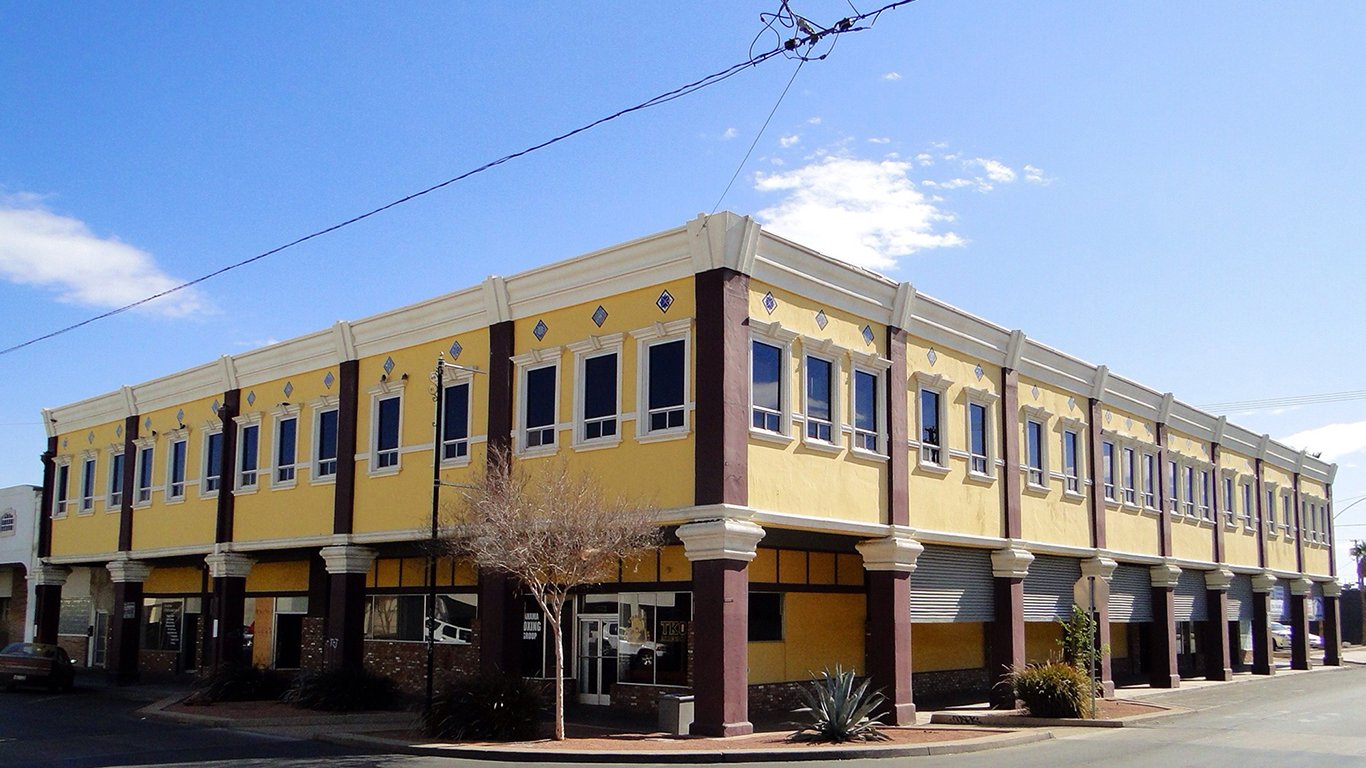
7. El Centro, CA
> Confirmed COVID-19 cases as of Feb. 17: 26,711
> Confirmed COVID-19 cases as of Feb. 17 per 100,000 residents: 14,821.7
> Cumulative COVID-19 deaths as of Feb. 17: 584
> Cumulative COVID-19 deaths as of Feb. 17 per 100,000 residents: 324.1
> Population: 180,216
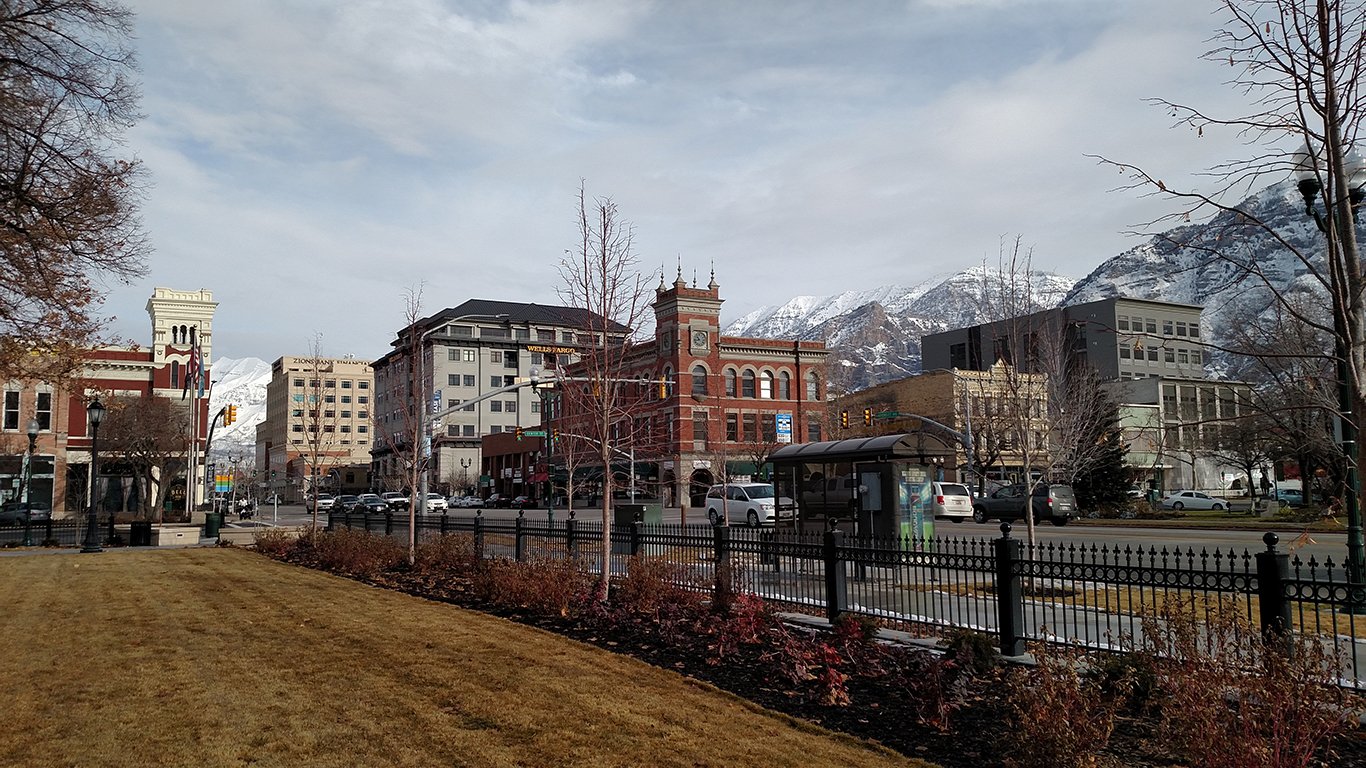
6. Provo-Orem, UT
> Confirmed COVID-19 cases as of Feb. 17: 88,217
> Confirmed COVID-19 cases as of Feb. 17 per 100,000 residents: 14,940.9
> Cumulative COVID-19 deaths as of Feb. 17: 308
> Cumulative COVID-19 deaths as of Feb. 17 per 100,000 residents: 52.2
> Population: 590,440
These are all the counties in Utah where COVID-19 is slowing (and where it’s still getting worse).
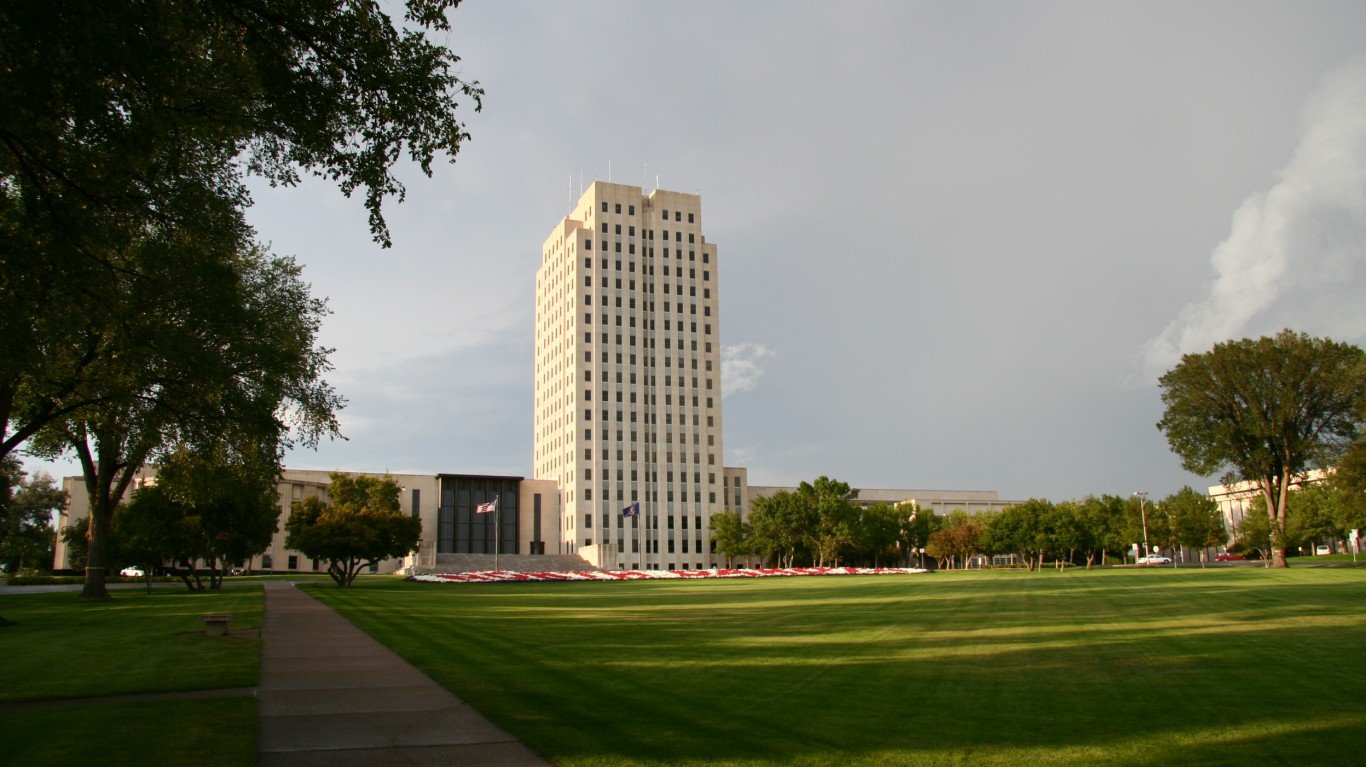
5. Bismarck, ND
> Confirmed COVID-19 cases as of Feb. 17: 19,563
> Confirmed COVID-19 cases as of Feb. 17 per 100,000 residents: 15,511.7
> Cumulative COVID-19 deaths as of Feb. 17: 281
> Cumulative COVID-19 deaths as of Feb. 17 per 100,000 residents: 222.8
> Population: 126,118

4. Laredo, TX
> Confirmed COVID-19 cases as of Feb. 17: 42,419
> Confirmed COVID-19 cases as of Feb. 17 per 100,000 residents: 15,592.2
> Cumulative COVID-19 deaths as of Feb. 17: 653
> Cumulative COVID-19 deaths as of Feb. 17 per 100,000 residents: 240
> Population: 272,053
These are all the counties in Texas where COVID-19 is slowing (and where it’s still getting worse).
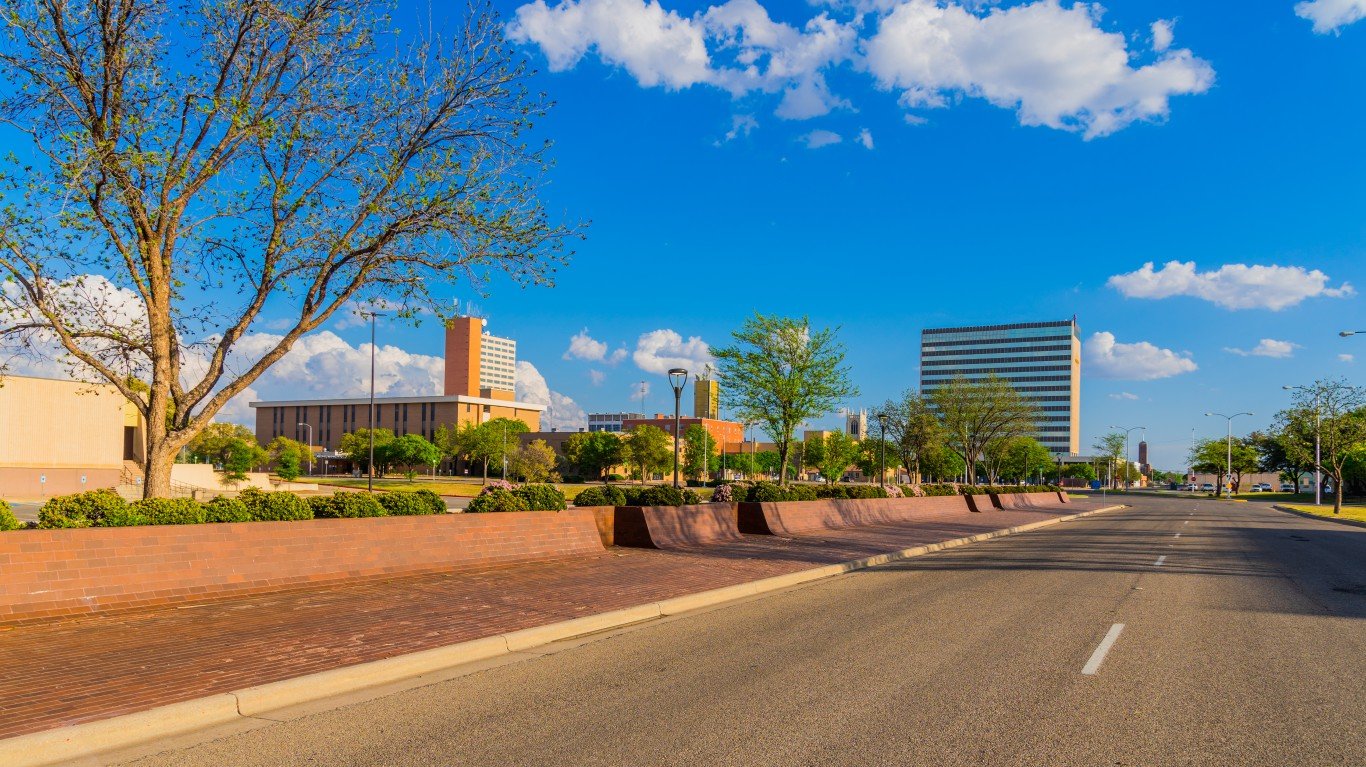
3. Lubbock, TX
> Confirmed COVID-19 cases as of Feb. 17: 48,955
> Confirmed COVID-19 cases as of Feb. 17 per 100,000 residents: 15,634.4
> Cumulative COVID-19 deaths as of Feb. 17: 796
> Cumulative COVID-19 deaths as of Feb. 17 per 100,000 residents: 254.2
> Population: 313,123
These are all the counties in Texas where COVID-19 is slowing (and where it’s still getting worse).
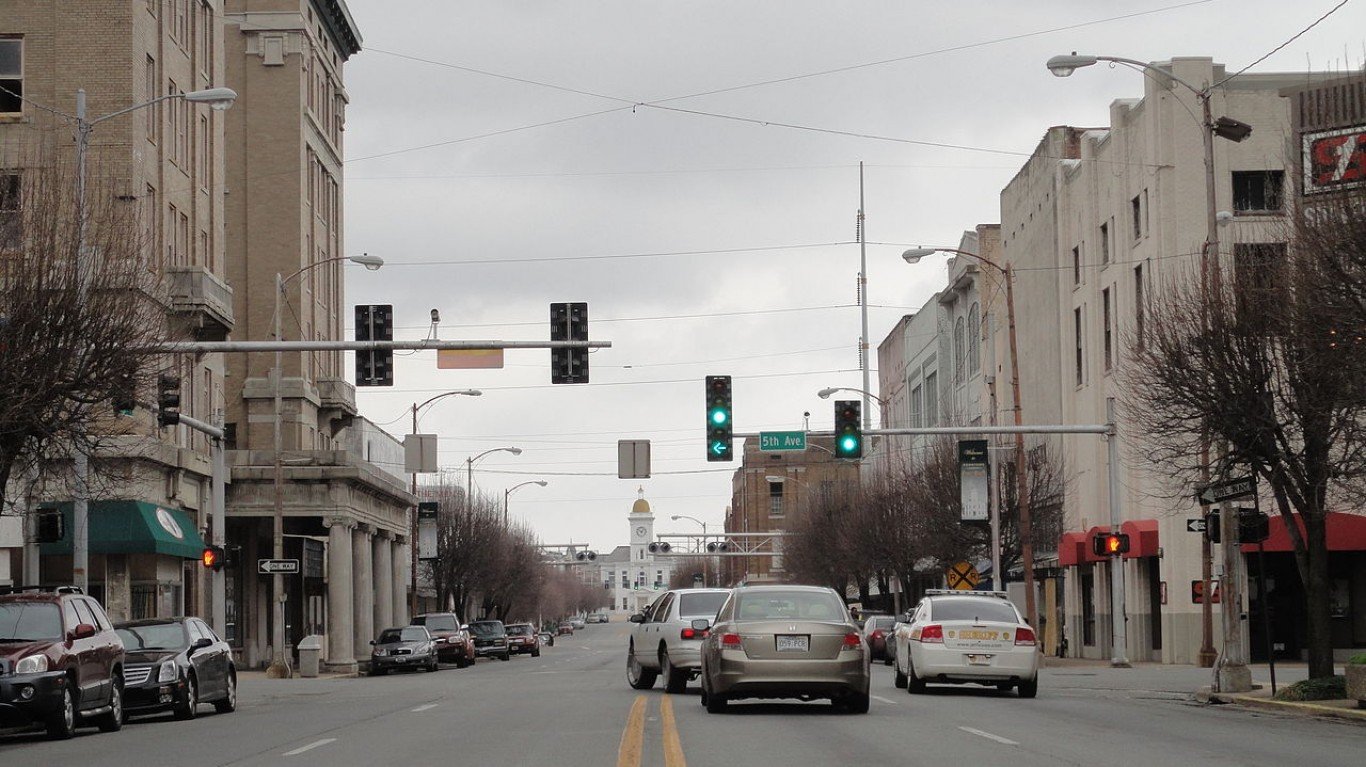
2. Pine Bluff, AR
> Confirmed COVID-19 cases as of Feb. 17: 15,185
> Confirmed COVID-19 cases as of Feb. 17 per 100,000 residents: 16,443.8
> Cumulative COVID-19 deaths as of Feb. 17: 277
> Cumulative COVID-19 deaths as of Feb. 17 per 100,000 residents: 300
> Population: 92,345
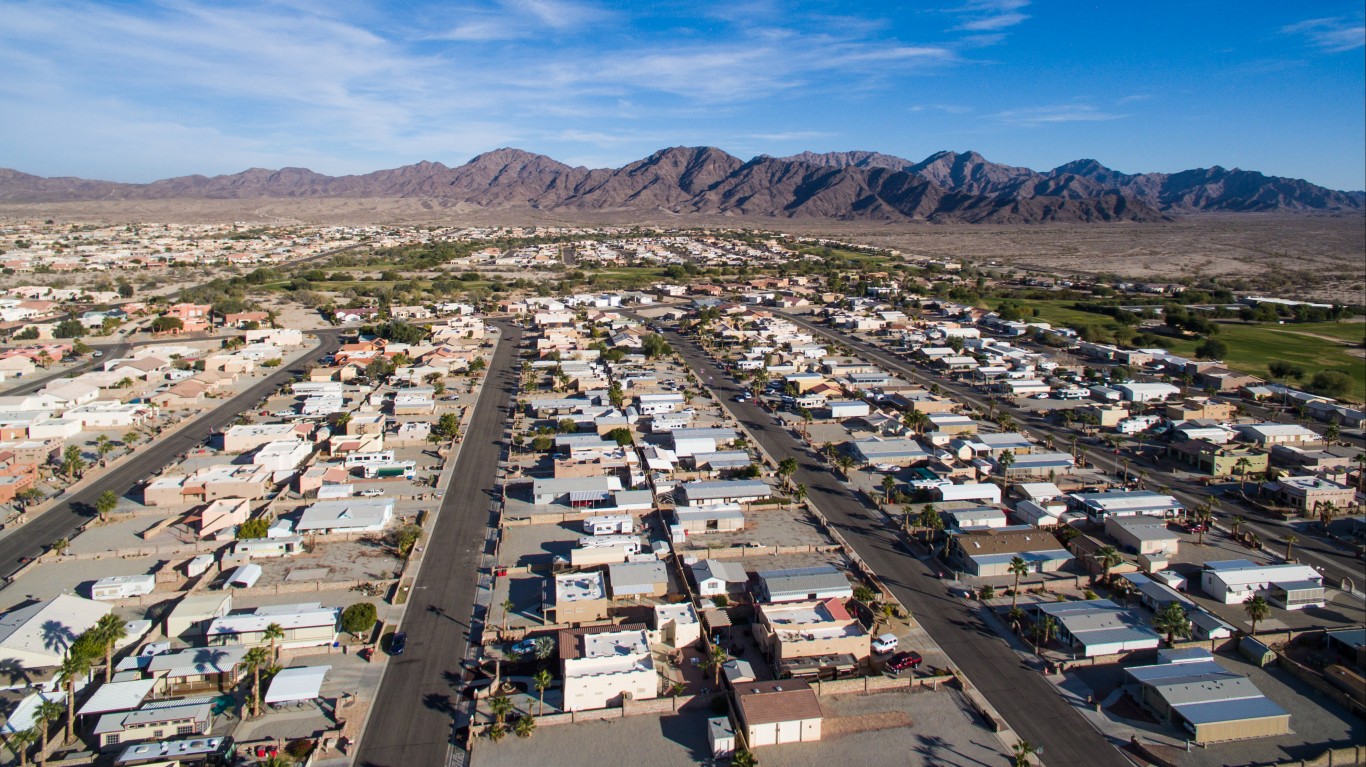
1. Yuma, AZ
> Confirmed COVID-19 cases as of Feb. 17: 36,160
> Confirmed COVID-19 cases as of Feb. 17 per 100,000 residents: 17,398.9
> Cumulative COVID-19 deaths as of Feb. 17: 762
> Cumulative COVID-19 deaths as of Feb. 17 per 100,000 residents: 366.6
> Population: 207,829
Click here to see all coronavirus data for every state.
Take This Retirement Quiz To Get Matched With An Advisor Now (Sponsored)
Are you ready for retirement? Planning for retirement can be overwhelming, that’s why it could be a good idea to speak to a fiduciary financial advisor about your goals today.
Start by taking this retirement quiz right here from SmartAsset that will match you with up to 3 financial advisors that serve your area and beyond in 5 minutes. Smart Asset is now matching over 50,000 people a month.
Click here now to get started.
Thank you for reading! Have some feedback for us?
Contact the 24/7 Wall St. editorial team.



